What Motivates Self-Management in Asthmatics?
VerifiedAdded on 2023/04/04
|17
|4599
|117
AI Summary
This literature review examines what motivates the use of asthma self-management in patients, practice nurses, general practitioners, and other related health professionals. It explores the impact of self-management on patient health outcomes and adherence to medication. The review includes a critical analysis of five qualitative studies from the UK and the Netherlands.
Contribute Materials
Your contribution can guide someone’s learning journey. Share your
documents today.
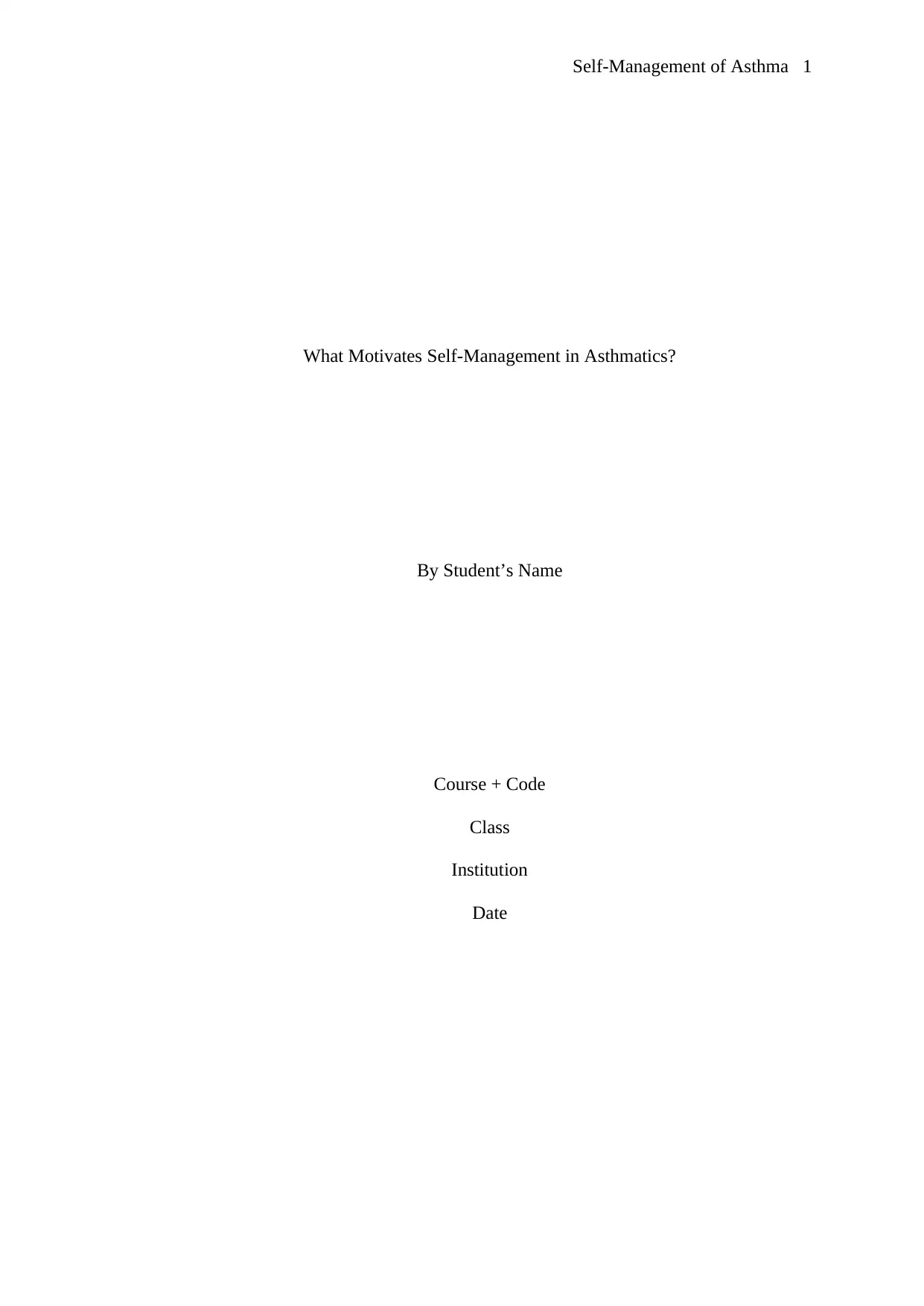
Self-Management of Asthma 1
What Motivates Self-Management in Asthmatics?
By Student’s Name
Course + Code
Class
Institution
Date
What Motivates Self-Management in Asthmatics?
By Student’s Name
Course + Code
Class
Institution
Date
Secure Best Marks with AI Grader
Need help grading? Try our AI Grader for instant feedback on your assignments.
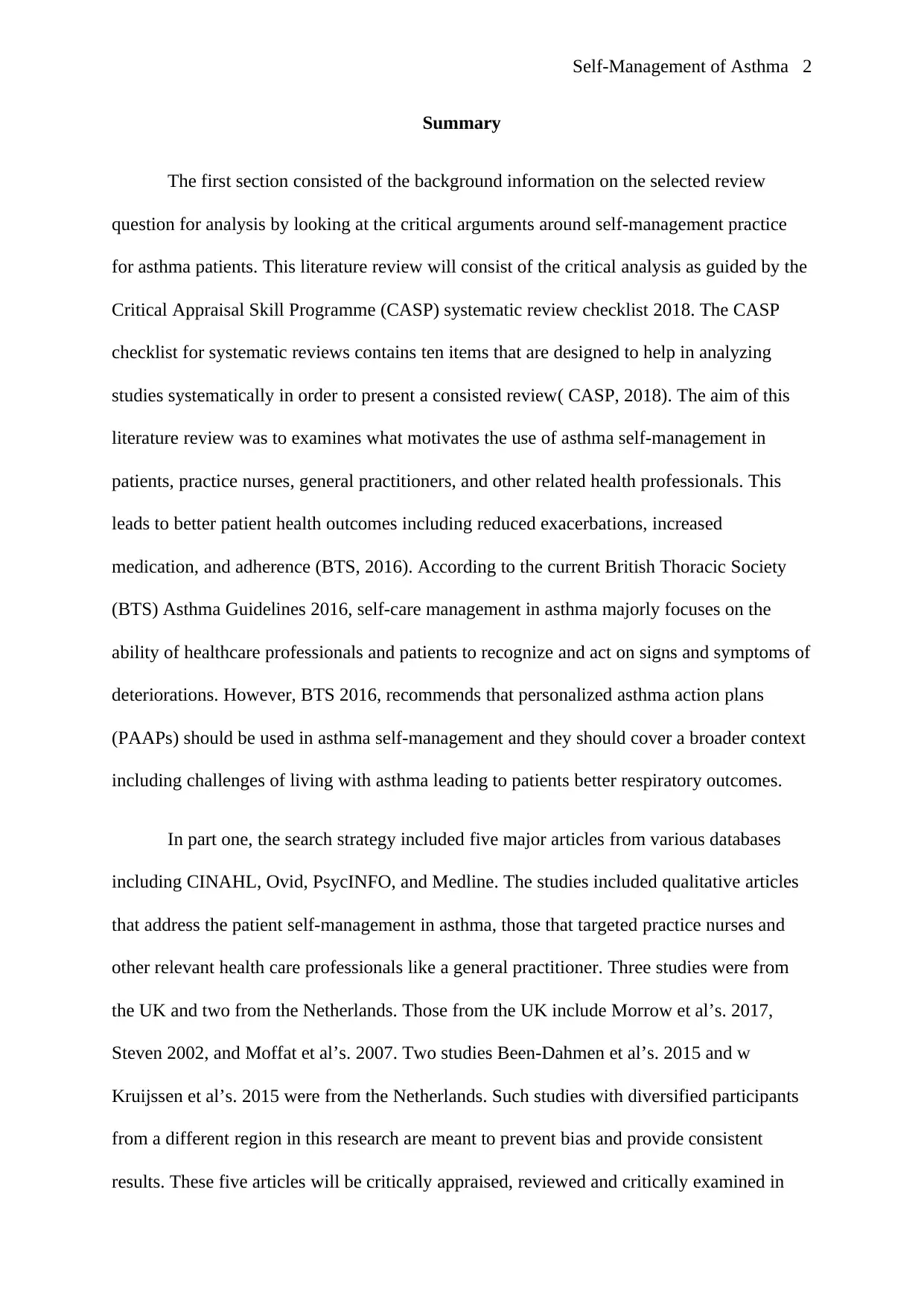
Self-Management of Asthma 2
Summary
The first section consisted of the background information on the selected review
question for analysis by looking at the critical arguments around self-management practice
for asthma patients. This literature review will consist of the critical analysis as guided by the
Critical Appraisal Skill Programme (CASP) systematic review checklist 2018. The CASP
checklist for systematic reviews contains ten items that are designed to help in analyzing
studies systematically in order to present a consisted review( CASP, 2018). The aim of this
literature review was to examines what motivates the use of asthma self-management in
patients, practice nurses, general practitioners, and other related health professionals. This
leads to better patient health outcomes including reduced exacerbations, increased
medication, and adherence (BTS, 2016). According to the current British Thoracic Society
(BTS) Asthma Guidelines 2016, self-care management in asthma majorly focuses on the
ability of healthcare professionals and patients to recognize and act on signs and symptoms of
deteriorations. However, BTS 2016, recommends that personalized asthma action plans
(PAAPs) should be used in asthma self-management and they should cover a broader context
including challenges of living with asthma leading to patients better respiratory outcomes.
In part one, the search strategy included five major articles from various databases
including CINAHL, Ovid, PsycINFO, and Medline. The studies included qualitative articles
that address the patient self-management in asthma, those that targeted practice nurses and
other relevant health care professionals like a general practitioner. Three studies were from
the UK and two from the Netherlands. Those from the UK include Morrow et al’s. 2017,
Steven 2002, and Moffat et al’s. 2007. Two studies Been-Dahmen et al’s. 2015 and w
Kruijssen et al’s. 2015 were from the Netherlands. Such studies with diversified participants
from a different region in this research are meant to prevent bias and provide consistent
results. These five articles will be critically appraised, reviewed and critically examined in
Summary
The first section consisted of the background information on the selected review
question for analysis by looking at the critical arguments around self-management practice
for asthma patients. This literature review will consist of the critical analysis as guided by the
Critical Appraisal Skill Programme (CASP) systematic review checklist 2018. The CASP
checklist for systematic reviews contains ten items that are designed to help in analyzing
studies systematically in order to present a consisted review( CASP, 2018). The aim of this
literature review was to examines what motivates the use of asthma self-management in
patients, practice nurses, general practitioners, and other related health professionals. This
leads to better patient health outcomes including reduced exacerbations, increased
medication, and adherence (BTS, 2016). According to the current British Thoracic Society
(BTS) Asthma Guidelines 2016, self-care management in asthma majorly focuses on the
ability of healthcare professionals and patients to recognize and act on signs and symptoms of
deteriorations. However, BTS 2016, recommends that personalized asthma action plans
(PAAPs) should be used in asthma self-management and they should cover a broader context
including challenges of living with asthma leading to patients better respiratory outcomes.
In part one, the search strategy included five major articles from various databases
including CINAHL, Ovid, PsycINFO, and Medline. The studies included qualitative articles
that address the patient self-management in asthma, those that targeted practice nurses and
other relevant health care professionals like a general practitioner. Three studies were from
the UK and two from the Netherlands. Those from the UK include Morrow et al’s. 2017,
Steven 2002, and Moffat et al’s. 2007. Two studies Been-Dahmen et al’s. 2015 and w
Kruijssen et al’s. 2015 were from the Netherlands. Such studies with diversified participants
from a different region in this research are meant to prevent bias and provide consistent
results. These five articles will be critically appraised, reviewed and critically examined in
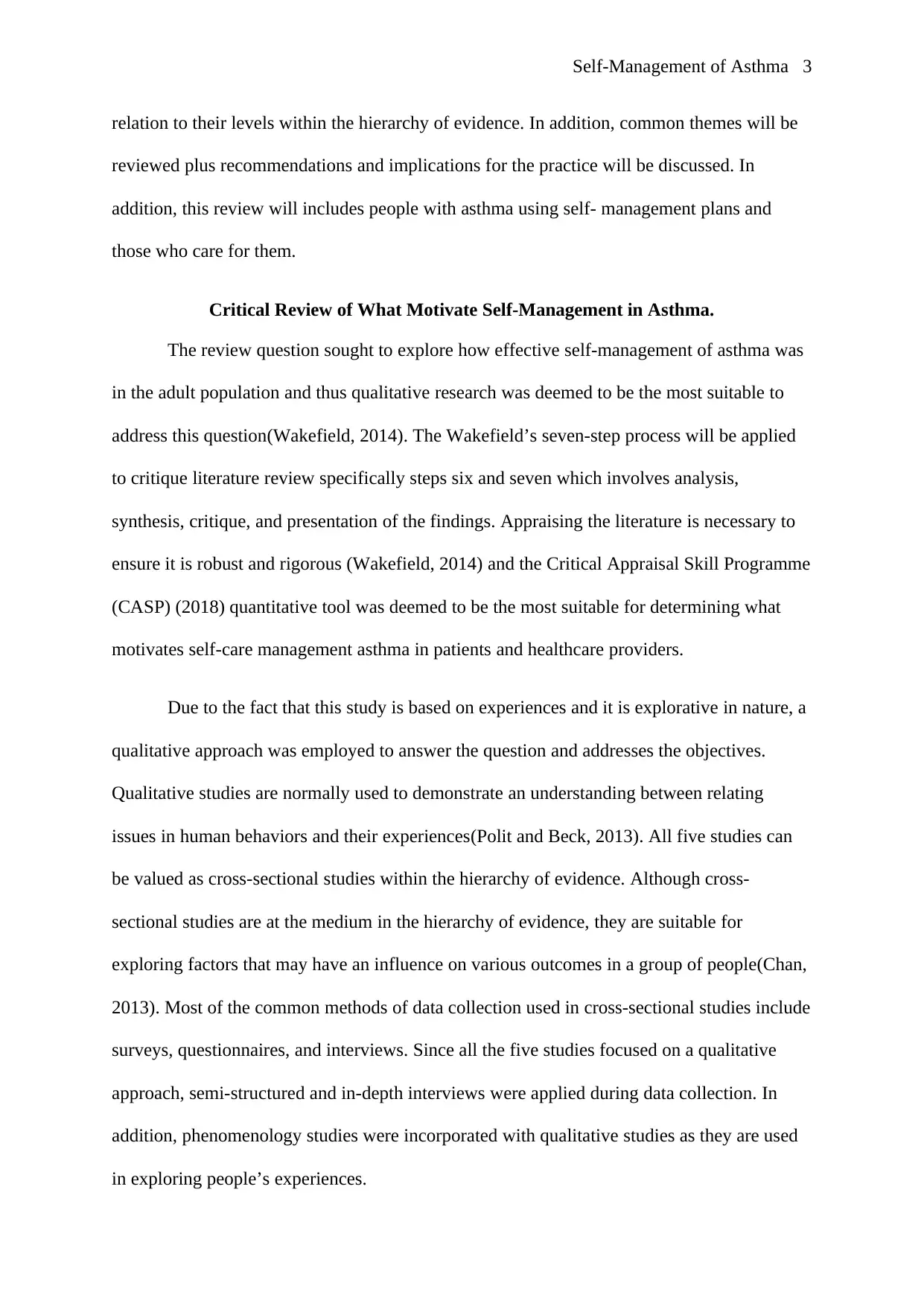
Self-Management of Asthma 3
relation to their levels within the hierarchy of evidence. In addition, common themes will be
reviewed plus recommendations and implications for the practice will be discussed. In
addition, this review will includes people with asthma using self- management plans and
those who care for them.
Critical Review of What Motivate Self-Management in Asthma.
The review question sought to explore how effective self-management of asthma was
in the adult population and thus qualitative research was deemed to be the most suitable to
address this question(Wakefield, 2014). The Wakefield’s seven-step process will be applied
to critique literature review specifically steps six and seven which involves analysis,
synthesis, critique, and presentation of the findings. Appraising the literature is necessary to
ensure it is robust and rigorous (Wakefield, 2014) and the Critical Appraisal Skill Programme
(CASP) (2018) quantitative tool was deemed to be the most suitable for determining what
motivates self-care management asthma in patients and healthcare providers.
Due to the fact that this study is based on experiences and it is explorative in nature, a
qualitative approach was employed to answer the question and addresses the objectives.
Qualitative studies are normally used to demonstrate an understanding between relating
issues in human behaviors and their experiences(Polit and Beck, 2013). All five studies can
be valued as cross-sectional studies within the hierarchy of evidence. Although cross-
sectional studies are at the medium in the hierarchy of evidence, they are suitable for
exploring factors that may have an influence on various outcomes in a group of people(Chan,
2013). Most of the common methods of data collection used in cross-sectional studies include
surveys, questionnaires, and interviews. Since all the five studies focused on a qualitative
approach, semi-structured and in-depth interviews were applied during data collection. In
addition, phenomenology studies were incorporated with qualitative studies as they are used
in exploring people’s experiences.
relation to their levels within the hierarchy of evidence. In addition, common themes will be
reviewed plus recommendations and implications for the practice will be discussed. In
addition, this review will includes people with asthma using self- management plans and
those who care for them.
Critical Review of What Motivate Self-Management in Asthma.
The review question sought to explore how effective self-management of asthma was
in the adult population and thus qualitative research was deemed to be the most suitable to
address this question(Wakefield, 2014). The Wakefield’s seven-step process will be applied
to critique literature review specifically steps six and seven which involves analysis,
synthesis, critique, and presentation of the findings. Appraising the literature is necessary to
ensure it is robust and rigorous (Wakefield, 2014) and the Critical Appraisal Skill Programme
(CASP) (2018) quantitative tool was deemed to be the most suitable for determining what
motivates self-care management asthma in patients and healthcare providers.
Due to the fact that this study is based on experiences and it is explorative in nature, a
qualitative approach was employed to answer the question and addresses the objectives.
Qualitative studies are normally used to demonstrate an understanding between relating
issues in human behaviors and their experiences(Polit and Beck, 2013). All five studies can
be valued as cross-sectional studies within the hierarchy of evidence. Although cross-
sectional studies are at the medium in the hierarchy of evidence, they are suitable for
exploring factors that may have an influence on various outcomes in a group of people(Chan,
2013). Most of the common methods of data collection used in cross-sectional studies include
surveys, questionnaires, and interviews. Since all the five studies focused on a qualitative
approach, semi-structured and in-depth interviews were applied during data collection. In
addition, phenomenology studies were incorporated with qualitative studies as they are used
in exploring people’s experiences.
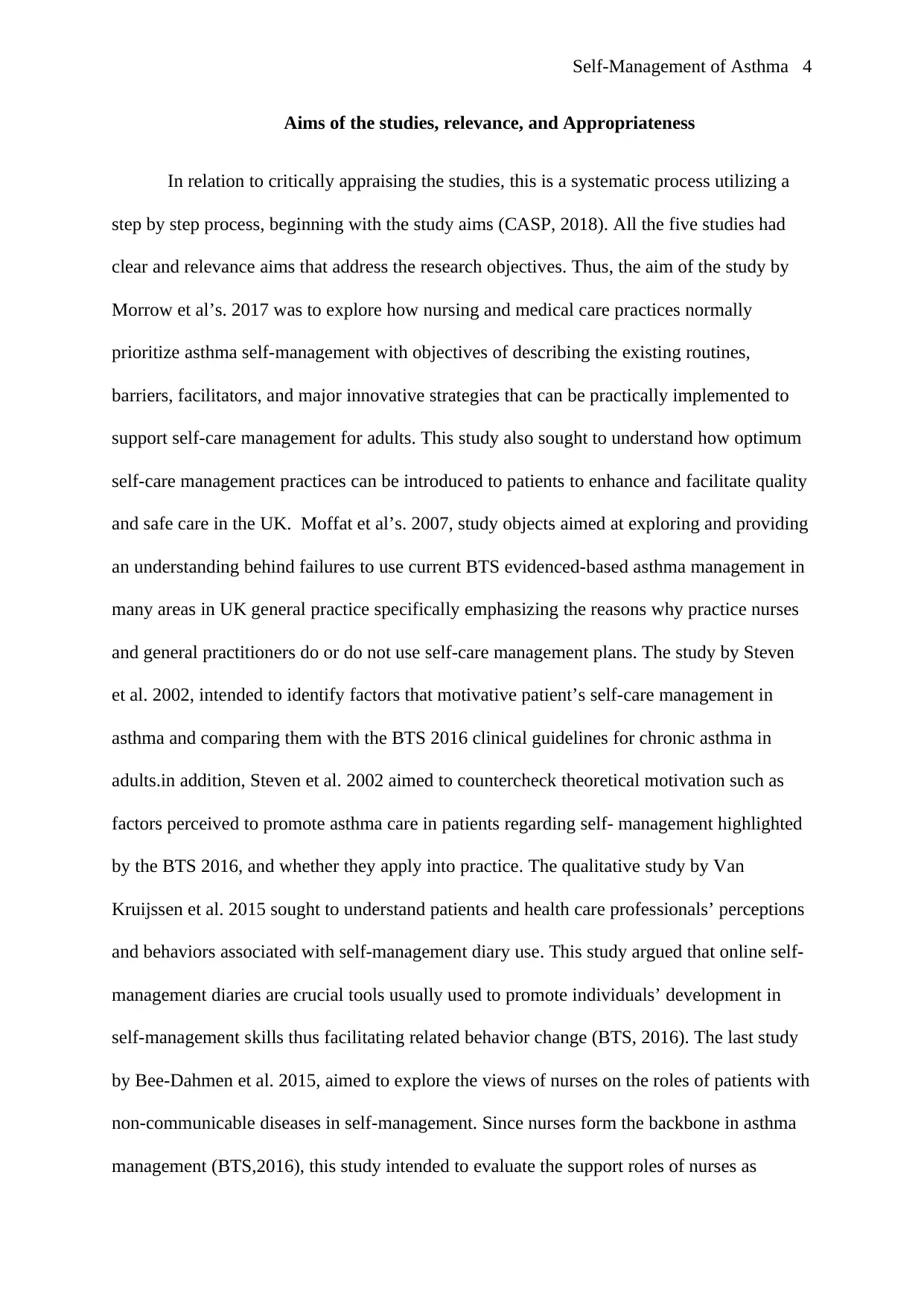
Self-Management of Asthma 4
Aims of the studies, relevance, and Appropriateness
In relation to critically appraising the studies, this is a systematic process utilizing a
step by step process, beginning with the study aims (CASP, 2018). All the five studies had
clear and relevance aims that address the research objectives. Thus, the aim of the study by
Morrow et al’s. 2017 was to explore how nursing and medical care practices normally
prioritize asthma self-management with objectives of describing the existing routines,
barriers, facilitators, and major innovative strategies that can be practically implemented to
support self-care management for adults. This study also sought to understand how optimum
self-care management practices can be introduced to patients to enhance and facilitate quality
and safe care in the UK. Moffat et al’s. 2007, study objects aimed at exploring and providing
an understanding behind failures to use current BTS evidenced-based asthma management in
many areas in UK general practice specifically emphasizing the reasons why practice nurses
and general practitioners do or do not use self-care management plans. The study by Steven
et al. 2002, intended to identify factors that motivative patient’s self-care management in
asthma and comparing them with the BTS 2016 clinical guidelines for chronic asthma in
adults.in addition, Steven et al. 2002 aimed to countercheck theoretical motivation such as
factors perceived to promote asthma care in patients regarding self- management highlighted
by the BTS 2016, and whether they apply into practice. The qualitative study by Van
Kruijssen et al. 2015 sought to understand patients and health care professionals’ perceptions
and behaviors associated with self-management diary use. This study argued that online self-
management diaries are crucial tools usually used to promote individuals’ development in
self-management skills thus facilitating related behavior change (BTS, 2016). The last study
by Bee-Dahmen et al. 2015, aimed to explore the views of nurses on the roles of patients with
non-communicable diseases in self-management. Since nurses form the backbone in asthma
management (BTS,2016), this study intended to evaluate the support roles of nurses as
Aims of the studies, relevance, and Appropriateness
In relation to critically appraising the studies, this is a systematic process utilizing a
step by step process, beginning with the study aims (CASP, 2018). All the five studies had
clear and relevance aims that address the research objectives. Thus, the aim of the study by
Morrow et al’s. 2017 was to explore how nursing and medical care practices normally
prioritize asthma self-management with objectives of describing the existing routines,
barriers, facilitators, and major innovative strategies that can be practically implemented to
support self-care management for adults. This study also sought to understand how optimum
self-care management practices can be introduced to patients to enhance and facilitate quality
and safe care in the UK. Moffat et al’s. 2007, study objects aimed at exploring and providing
an understanding behind failures to use current BTS evidenced-based asthma management in
many areas in UK general practice specifically emphasizing the reasons why practice nurses
and general practitioners do or do not use self-care management plans. The study by Steven
et al. 2002, intended to identify factors that motivative patient’s self-care management in
asthma and comparing them with the BTS 2016 clinical guidelines for chronic asthma in
adults.in addition, Steven et al. 2002 aimed to countercheck theoretical motivation such as
factors perceived to promote asthma care in patients regarding self- management highlighted
by the BTS 2016, and whether they apply into practice. The qualitative study by Van
Kruijssen et al. 2015 sought to understand patients and health care professionals’ perceptions
and behaviors associated with self-management diary use. This study argued that online self-
management diaries are crucial tools usually used to promote individuals’ development in
self-management skills thus facilitating related behavior change (BTS, 2016). The last study
by Bee-Dahmen et al. 2015, aimed to explore the views of nurses on the roles of patients with
non-communicable diseases in self-management. Since nurses form the backbone in asthma
management (BTS,2016), this study intended to evaluate the support roles of nurses as
Secure Best Marks with AI Grader
Need help grading? Try our AI Grader for instant feedback on your assignments.
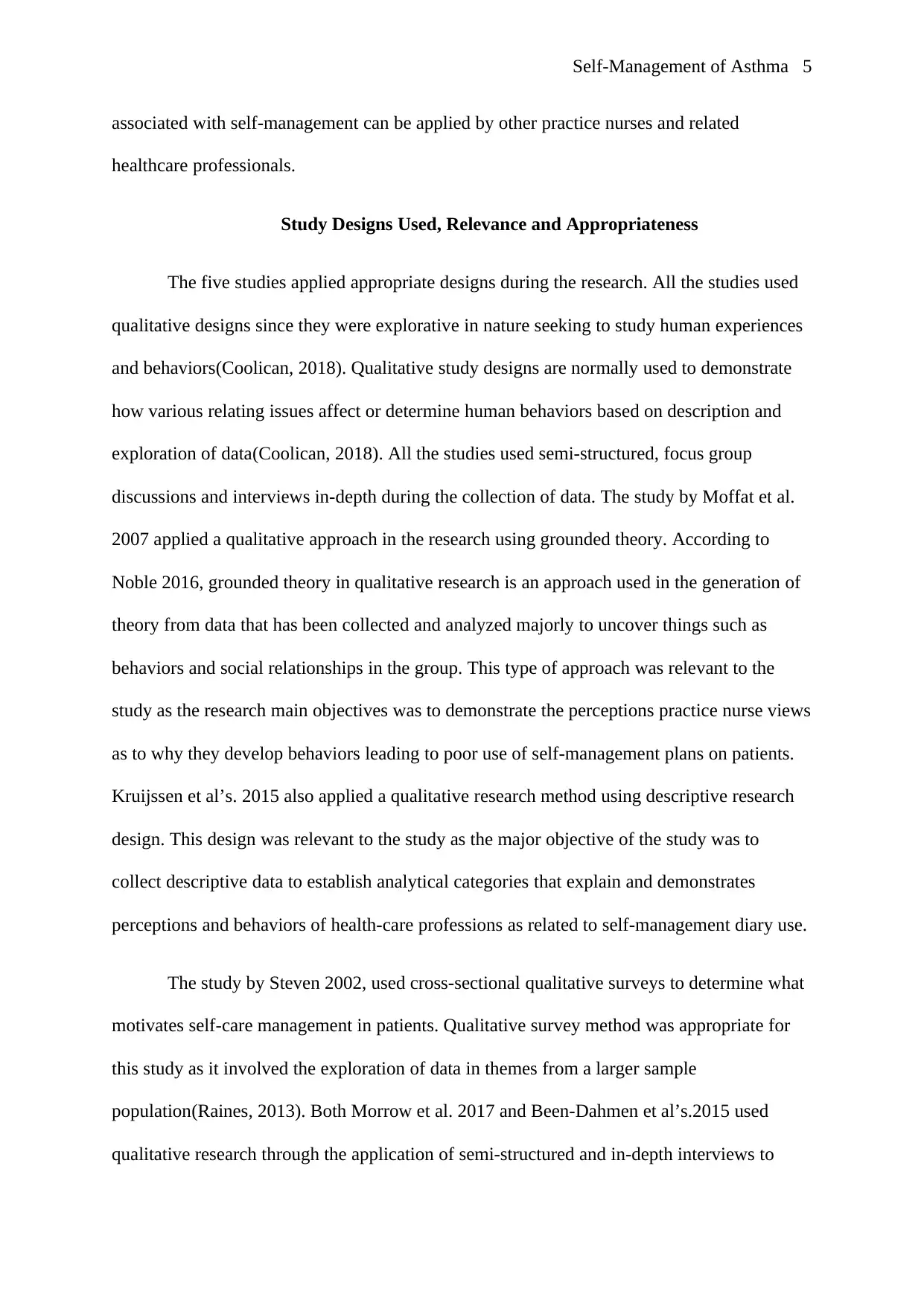
Self-Management of Asthma 5
associated with self-management can be applied by other practice nurses and related
healthcare professionals.
Study Designs Used, Relevance and Appropriateness
The five studies applied appropriate designs during the research. All the studies used
qualitative designs since they were explorative in nature seeking to study human experiences
and behaviors(Coolican, 2018). Qualitative study designs are normally used to demonstrate
how various relating issues affect or determine human behaviors based on description and
exploration of data(Coolican, 2018). All the studies used semi-structured, focus group
discussions and interviews in-depth during the collection of data. The study by Moffat et al.
2007 applied a qualitative approach in the research using grounded theory. According to
Noble 2016, grounded theory in qualitative research is an approach used in the generation of
theory from data that has been collected and analyzed majorly to uncover things such as
behaviors and social relationships in the group. This type of approach was relevant to the
study as the research main objectives was to demonstrate the perceptions practice nurse views
as to why they develop behaviors leading to poor use of self-management plans on patients.
Kruijssen et al’s. 2015 also applied a qualitative research method using descriptive research
design. This design was relevant to the study as the major objective of the study was to
collect descriptive data to establish analytical categories that explain and demonstrates
perceptions and behaviors of health-care professions as related to self-management diary use.
The study by Steven 2002, used cross-sectional qualitative surveys to determine what
motivates self-care management in patients. Qualitative survey method was appropriate for
this study as it involved the exploration of data in themes from a larger sample
population(Raines, 2013). Both Morrow et al. 2017 and Been-Dahmen et al’s.2015 used
qualitative research through the application of semi-structured and in-depth interviews to
associated with self-management can be applied by other practice nurses and related
healthcare professionals.
Study Designs Used, Relevance and Appropriateness
The five studies applied appropriate designs during the research. All the studies used
qualitative designs since they were explorative in nature seeking to study human experiences
and behaviors(Coolican, 2018). Qualitative study designs are normally used to demonstrate
how various relating issues affect or determine human behaviors based on description and
exploration of data(Coolican, 2018). All the studies used semi-structured, focus group
discussions and interviews in-depth during the collection of data. The study by Moffat et al.
2007 applied a qualitative approach in the research using grounded theory. According to
Noble 2016, grounded theory in qualitative research is an approach used in the generation of
theory from data that has been collected and analyzed majorly to uncover things such as
behaviors and social relationships in the group. This type of approach was relevant to the
study as the research main objectives was to demonstrate the perceptions practice nurse views
as to why they develop behaviors leading to poor use of self-management plans on patients.
Kruijssen et al’s. 2015 also applied a qualitative research method using descriptive research
design. This design was relevant to the study as the major objective of the study was to
collect descriptive data to establish analytical categories that explain and demonstrates
perceptions and behaviors of health-care professions as related to self-management diary use.
The study by Steven 2002, used cross-sectional qualitative surveys to determine what
motivates self-care management in patients. Qualitative survey method was appropriate for
this study as it involved the exploration of data in themes from a larger sample
population(Raines, 2013). Both Morrow et al. 2017 and Been-Dahmen et al’s.2015 used
qualitative research through the application of semi-structured and in-depth interviews to
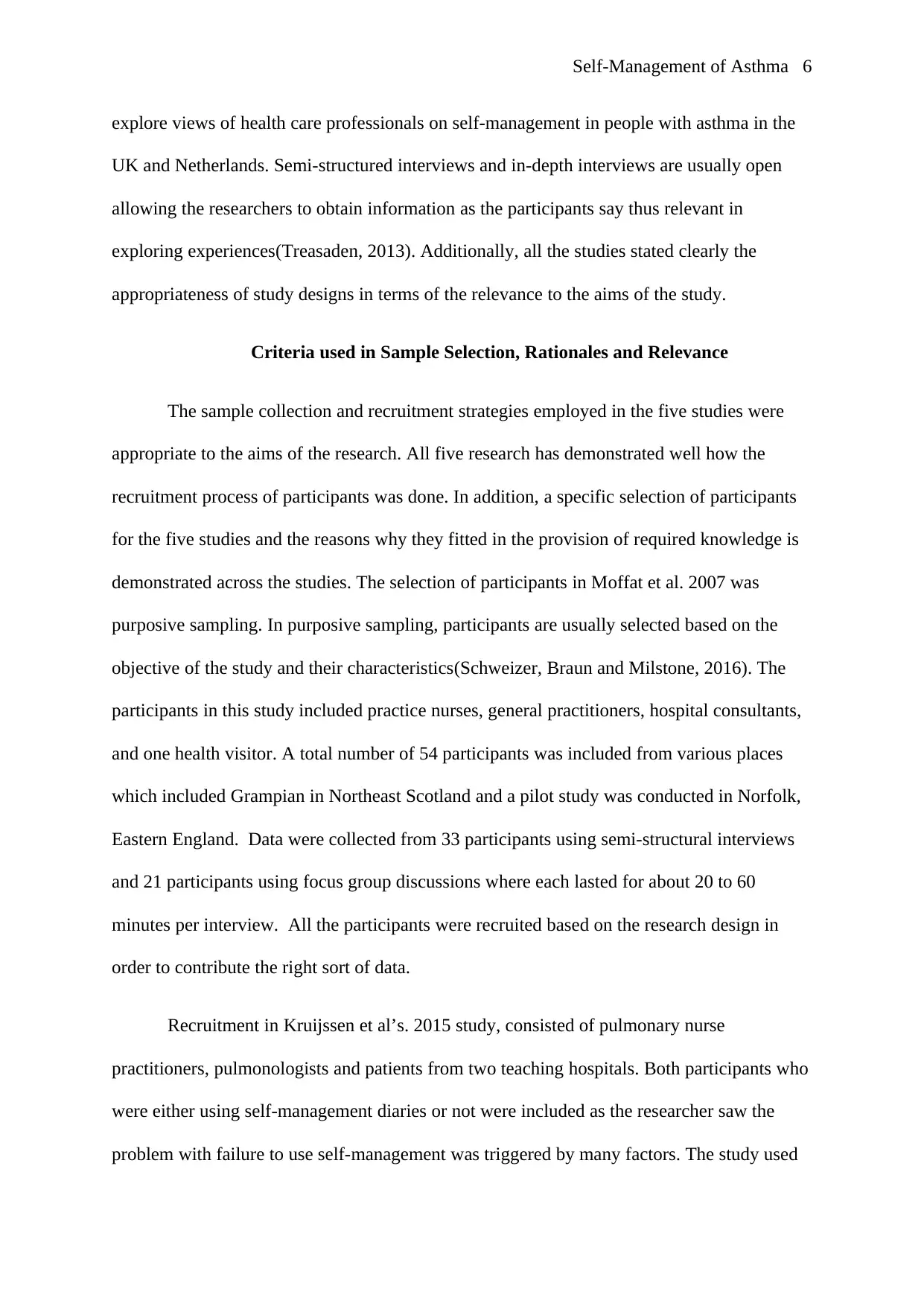
Self-Management of Asthma 6
explore views of health care professionals on self-management in people with asthma in the
UK and Netherlands. Semi-structured interviews and in-depth interviews are usually open
allowing the researchers to obtain information as the participants say thus relevant in
exploring experiences(Treasaden, 2013). Additionally, all the studies stated clearly the
appropriateness of study designs in terms of the relevance to the aims of the study.
Criteria used in Sample Selection, Rationales and Relevance
The sample collection and recruitment strategies employed in the five studies were
appropriate to the aims of the research. All five research has demonstrated well how the
recruitment process of participants was done. In addition, a specific selection of participants
for the five studies and the reasons why they fitted in the provision of required knowledge is
demonstrated across the studies. The selection of participants in Moffat et al. 2007 was
purposive sampling. In purposive sampling, participants are usually selected based on the
objective of the study and their characteristics(Schweizer, Braun and Milstone, 2016). The
participants in this study included practice nurses, general practitioners, hospital consultants,
and one health visitor. A total number of 54 participants was included from various places
which included Grampian in Northeast Scotland and a pilot study was conducted in Norfolk,
Eastern England. Data were collected from 33 participants using semi-structural interviews
and 21 participants using focus group discussions where each lasted for about 20 to 60
minutes per interview. All the participants were recruited based on the research design in
order to contribute the right sort of data.
Recruitment in Kruijssen et al’s. 2015 study, consisted of pulmonary nurse
practitioners, pulmonologists and patients from two teaching hospitals. Both participants who
were either using self-management diaries or not were included as the researcher saw the
problem with failure to use self-management was triggered by many factors. The study used
explore views of health care professionals on self-management in people with asthma in the
UK and Netherlands. Semi-structured interviews and in-depth interviews are usually open
allowing the researchers to obtain information as the participants say thus relevant in
exploring experiences(Treasaden, 2013). Additionally, all the studies stated clearly the
appropriateness of study designs in terms of the relevance to the aims of the study.
Criteria used in Sample Selection, Rationales and Relevance
The sample collection and recruitment strategies employed in the five studies were
appropriate to the aims of the research. All five research has demonstrated well how the
recruitment process of participants was done. In addition, a specific selection of participants
for the five studies and the reasons why they fitted in the provision of required knowledge is
demonstrated across the studies. The selection of participants in Moffat et al. 2007 was
purposive sampling. In purposive sampling, participants are usually selected based on the
objective of the study and their characteristics(Schweizer, Braun and Milstone, 2016). The
participants in this study included practice nurses, general practitioners, hospital consultants,
and one health visitor. A total number of 54 participants was included from various places
which included Grampian in Northeast Scotland and a pilot study was conducted in Norfolk,
Eastern England. Data were collected from 33 participants using semi-structural interviews
and 21 participants using focus group discussions where each lasted for about 20 to 60
minutes per interview. All the participants were recruited based on the research design in
order to contribute the right sort of data.
Recruitment in Kruijssen et al’s. 2015 study, consisted of pulmonary nurse
practitioners, pulmonologists and patients from two teaching hospitals. Both participants who
were either using self-management diaries or not were included as the researcher saw the
problem with failure to use self-management was triggered by many factors. The study used
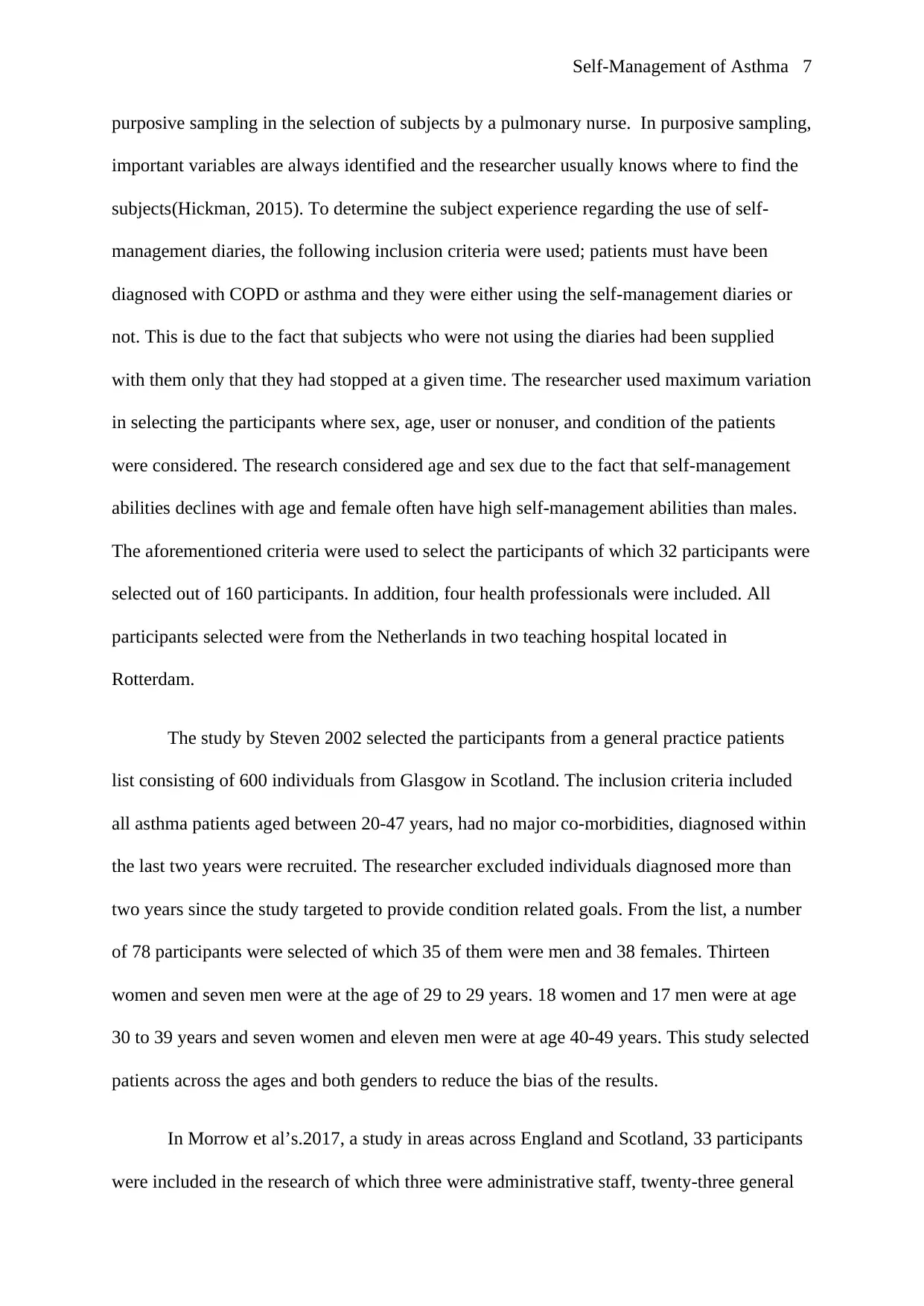
Self-Management of Asthma 7
purposive sampling in the selection of subjects by a pulmonary nurse. In purposive sampling,
important variables are always identified and the researcher usually knows where to find the
subjects(Hickman, 2015). To determine the subject experience regarding the use of self-
management diaries, the following inclusion criteria were used; patients must have been
diagnosed with COPD or asthma and they were either using the self-management diaries or
not. This is due to the fact that subjects who were not using the diaries had been supplied
with them only that they had stopped at a given time. The researcher used maximum variation
in selecting the participants where sex, age, user or nonuser, and condition of the patients
were considered. The research considered age and sex due to the fact that self-management
abilities declines with age and female often have high self-management abilities than males.
The aforementioned criteria were used to select the participants of which 32 participants were
selected out of 160 participants. In addition, four health professionals were included. All
participants selected were from the Netherlands in two teaching hospital located in
Rotterdam.
The study by Steven 2002 selected the participants from a general practice patients
list consisting of 600 individuals from Glasgow in Scotland. The inclusion criteria included
all asthma patients aged between 20-47 years, had no major co-morbidities, diagnosed within
the last two years were recruited. The researcher excluded individuals diagnosed more than
two years since the study targeted to provide condition related goals. From the list, a number
of 78 participants were selected of which 35 of them were men and 38 females. Thirteen
women and seven men were at the age of 29 to 29 years. 18 women and 17 men were at age
30 to 39 years and seven women and eleven men were at age 40-49 years. This study selected
patients across the ages and both genders to reduce the bias of the results.
In Morrow et al’s.2017, a study in areas across England and Scotland, 33 participants
were included in the research of which three were administrative staff, twenty-three general
purposive sampling in the selection of subjects by a pulmonary nurse. In purposive sampling,
important variables are always identified and the researcher usually knows where to find the
subjects(Hickman, 2015). To determine the subject experience regarding the use of self-
management diaries, the following inclusion criteria were used; patients must have been
diagnosed with COPD or asthma and they were either using the self-management diaries or
not. This is due to the fact that subjects who were not using the diaries had been supplied
with them only that they had stopped at a given time. The researcher used maximum variation
in selecting the participants where sex, age, user or nonuser, and condition of the patients
were considered. The research considered age and sex due to the fact that self-management
abilities declines with age and female often have high self-management abilities than males.
The aforementioned criteria were used to select the participants of which 32 participants were
selected out of 160 participants. In addition, four health professionals were included. All
participants selected were from the Netherlands in two teaching hospital located in
Rotterdam.
The study by Steven 2002 selected the participants from a general practice patients
list consisting of 600 individuals from Glasgow in Scotland. The inclusion criteria included
all asthma patients aged between 20-47 years, had no major co-morbidities, diagnosed within
the last two years were recruited. The researcher excluded individuals diagnosed more than
two years since the study targeted to provide condition related goals. From the list, a number
of 78 participants were selected of which 35 of them were men and 38 females. Thirteen
women and seven men were at the age of 29 to 29 years. 18 women and 17 men were at age
30 to 39 years and seven women and eleven men were at age 40-49 years. This study selected
patients across the ages and both genders to reduce the bias of the results.
In Morrow et al’s.2017, a study in areas across England and Scotland, 33 participants
were included in the research of which three were administrative staff, twenty-three general
Paraphrase This Document
Need a fresh take? Get an instant paraphrase of this document with our AI Paraphraser
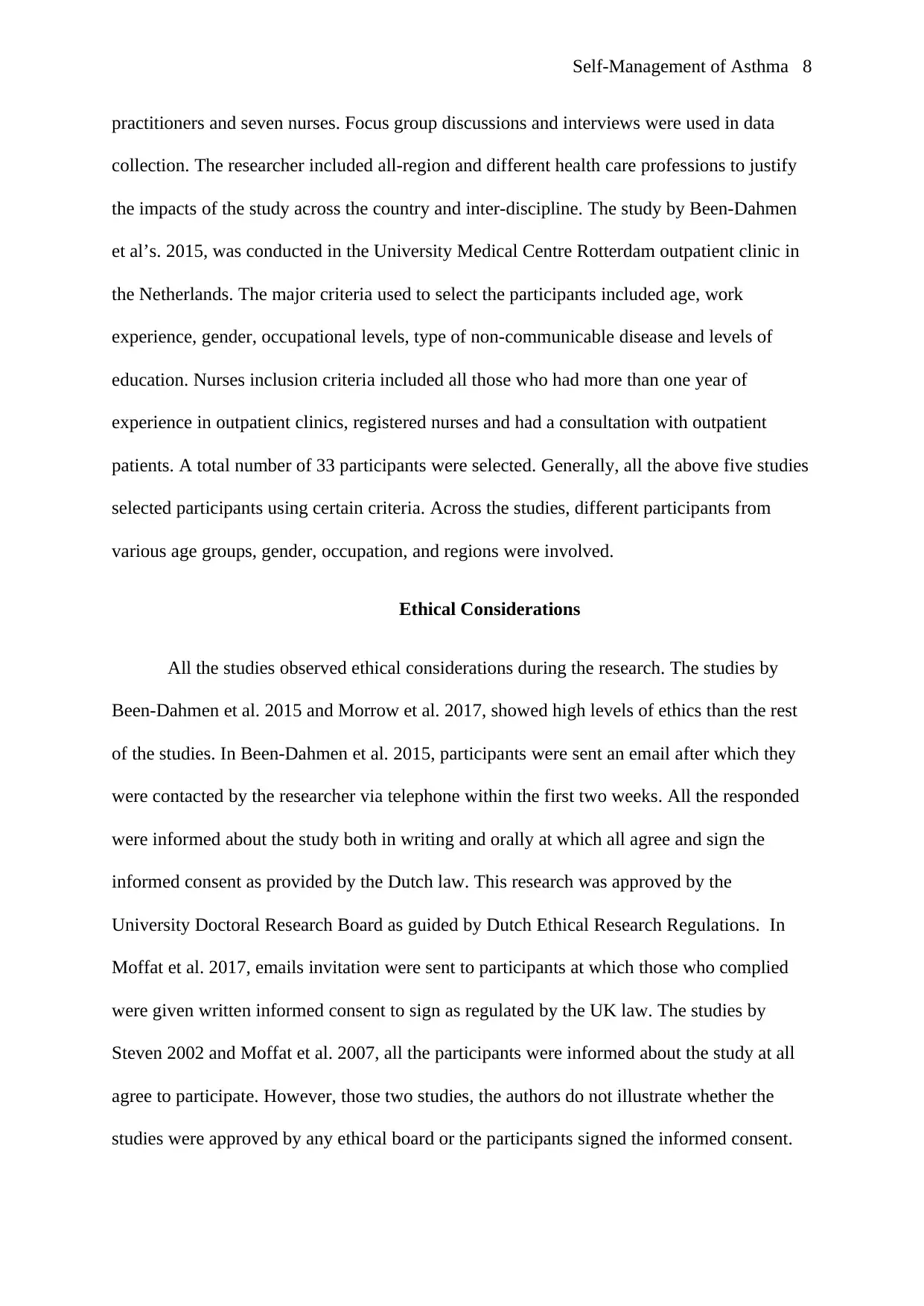
Self-Management of Asthma 8
practitioners and seven nurses. Focus group discussions and interviews were used in data
collection. The researcher included all-region and different health care professions to justify
the impacts of the study across the country and inter-discipline. The study by Been-Dahmen
et al’s. 2015, was conducted in the University Medical Centre Rotterdam outpatient clinic in
the Netherlands. The major criteria used to select the participants included age, work
experience, gender, occupational levels, type of non-communicable disease and levels of
education. Nurses inclusion criteria included all those who had more than one year of
experience in outpatient clinics, registered nurses and had a consultation with outpatient
patients. A total number of 33 participants were selected. Generally, all the above five studies
selected participants using certain criteria. Across the studies, different participants from
various age groups, gender, occupation, and regions were involved.
Ethical Considerations
All the studies observed ethical considerations during the research. The studies by
Been-Dahmen et al. 2015 and Morrow et al. 2017, showed high levels of ethics than the rest
of the studies. In Been-Dahmen et al. 2015, participants were sent an email after which they
were contacted by the researcher via telephone within the first two weeks. All the responded
were informed about the study both in writing and orally at which all agree and sign the
informed consent as provided by the Dutch law. This research was approved by the
University Doctoral Research Board as guided by Dutch Ethical Research Regulations. In
Moffat et al. 2017, emails invitation were sent to participants at which those who complied
were given written informed consent to sign as regulated by the UK law. The studies by
Steven 2002 and Moffat et al. 2007, all the participants were informed about the study at all
agree to participate. However, those two studies, the authors do not illustrate whether the
studies were approved by any ethical board or the participants signed the informed consent.
practitioners and seven nurses. Focus group discussions and interviews were used in data
collection. The researcher included all-region and different health care professions to justify
the impacts of the study across the country and inter-discipline. The study by Been-Dahmen
et al’s. 2015, was conducted in the University Medical Centre Rotterdam outpatient clinic in
the Netherlands. The major criteria used to select the participants included age, work
experience, gender, occupational levels, type of non-communicable disease and levels of
education. Nurses inclusion criteria included all those who had more than one year of
experience in outpatient clinics, registered nurses and had a consultation with outpatient
patients. A total number of 33 participants were selected. Generally, all the above five studies
selected participants using certain criteria. Across the studies, different participants from
various age groups, gender, occupation, and regions were involved.
Ethical Considerations
All the studies observed ethical considerations during the research. The studies by
Been-Dahmen et al. 2015 and Morrow et al. 2017, showed high levels of ethics than the rest
of the studies. In Been-Dahmen et al. 2015, participants were sent an email after which they
were contacted by the researcher via telephone within the first two weeks. All the responded
were informed about the study both in writing and orally at which all agree and sign the
informed consent as provided by the Dutch law. This research was approved by the
University Doctoral Research Board as guided by Dutch Ethical Research Regulations. In
Moffat et al. 2017, emails invitation were sent to participants at which those who complied
were given written informed consent to sign as regulated by the UK law. The studies by
Steven 2002 and Moffat et al. 2007, all the participants were informed about the study at all
agree to participate. However, those two studies, the authors do not illustrate whether the
studies were approved by any ethical board or the participants signed the informed consent.
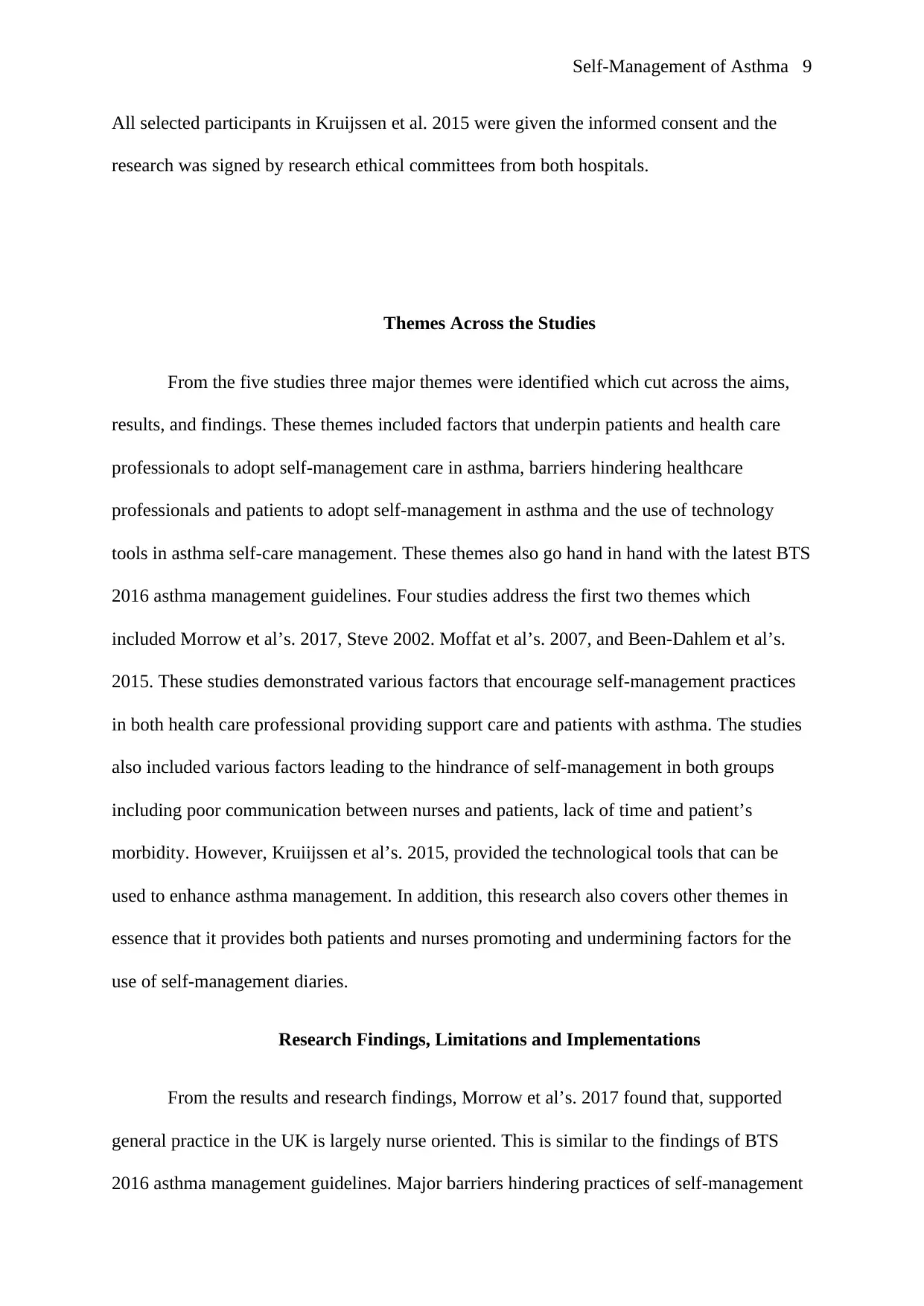
Self-Management of Asthma 9
All selected participants in Kruijssen et al. 2015 were given the informed consent and the
research was signed by research ethical committees from both hospitals.
Themes Across the Studies
From the five studies three major themes were identified which cut across the aims,
results, and findings. These themes included factors that underpin patients and health care
professionals to adopt self-management care in asthma, barriers hindering healthcare
professionals and patients to adopt self-management in asthma and the use of technology
tools in asthma self-care management. These themes also go hand in hand with the latest BTS
2016 asthma management guidelines. Four studies address the first two themes which
included Morrow et al’s. 2017, Steve 2002. Moffat et al’s. 2007, and Been-Dahlem et al’s.
2015. These studies demonstrated various factors that encourage self-management practices
in both health care professional providing support care and patients with asthma. The studies
also included various factors leading to the hindrance of self-management in both groups
including poor communication between nurses and patients, lack of time and patient’s
morbidity. However, Kruiijssen et al’s. 2015, provided the technological tools that can be
used to enhance asthma management. In addition, this research also covers other themes in
essence that it provides both patients and nurses promoting and undermining factors for the
use of self-management diaries.
Research Findings, Limitations and Implementations
From the results and research findings, Morrow et al’s. 2017 found that, supported
general practice in the UK is largely nurse oriented. This is similar to the findings of BTS
2016 asthma management guidelines. Major barriers hindering practices of self-management
All selected participants in Kruijssen et al. 2015 were given the informed consent and the
research was signed by research ethical committees from both hospitals.
Themes Across the Studies
From the five studies three major themes were identified which cut across the aims,
results, and findings. These themes included factors that underpin patients and health care
professionals to adopt self-management care in asthma, barriers hindering healthcare
professionals and patients to adopt self-management in asthma and the use of technology
tools in asthma self-care management. These themes also go hand in hand with the latest BTS
2016 asthma management guidelines. Four studies address the first two themes which
included Morrow et al’s. 2017, Steve 2002. Moffat et al’s. 2007, and Been-Dahlem et al’s.
2015. These studies demonstrated various factors that encourage self-management practices
in both health care professional providing support care and patients with asthma. The studies
also included various factors leading to the hindrance of self-management in both groups
including poor communication between nurses and patients, lack of time and patient’s
morbidity. However, Kruiijssen et al’s. 2015, provided the technological tools that can be
used to enhance asthma management. In addition, this research also covers other themes in
essence that it provides both patients and nurses promoting and undermining factors for the
use of self-management diaries.
Research Findings, Limitations and Implementations
From the results and research findings, Morrow et al’s. 2017 found that, supported
general practice in the UK is largely nurse oriented. This is similar to the findings of BTS
2016 asthma management guidelines. Major barriers hindering practices of self-management
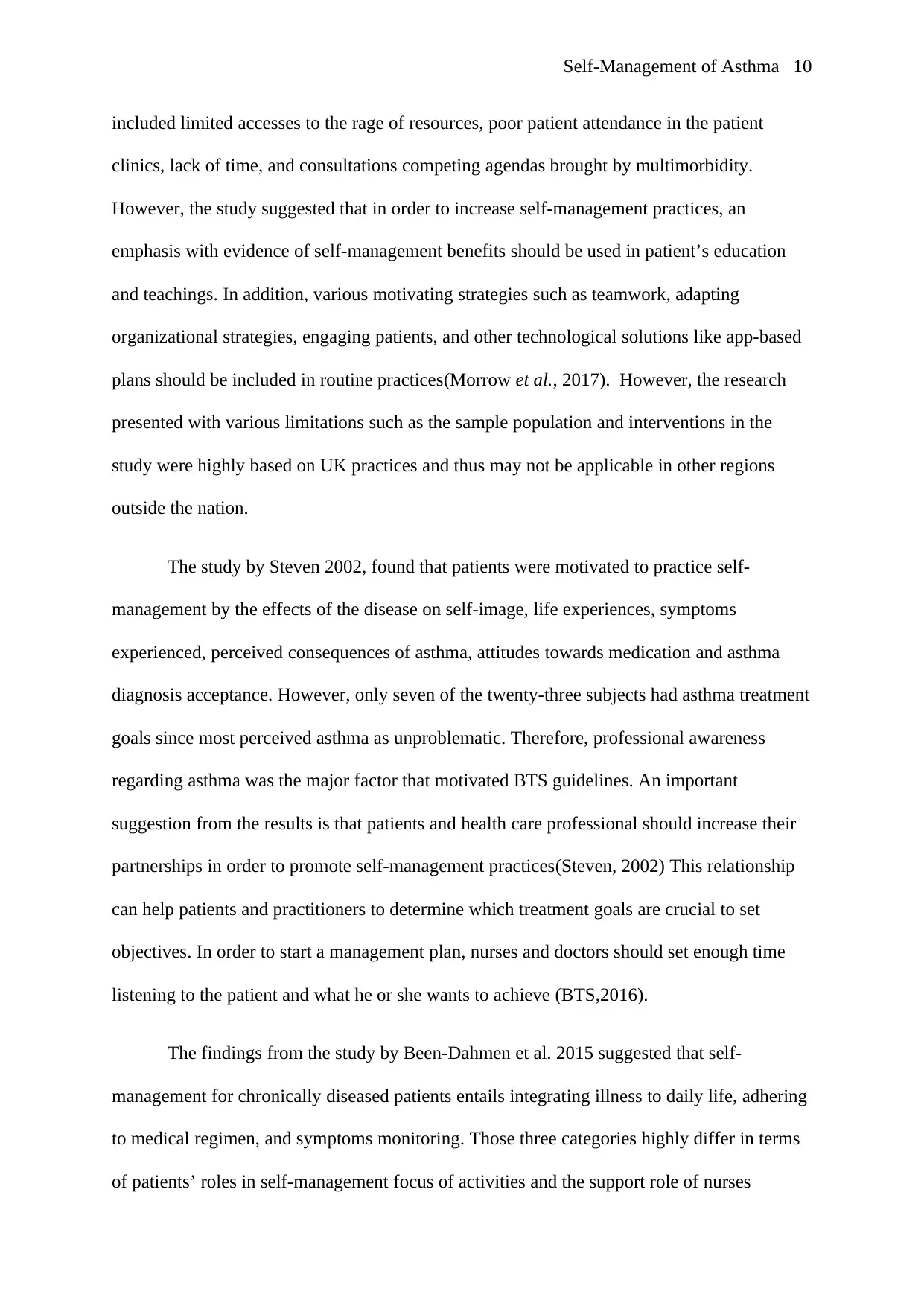
Self-Management of Asthma 10
included limited accesses to the rage of resources, poor patient attendance in the patient
clinics, lack of time, and consultations competing agendas brought by multimorbidity.
However, the study suggested that in order to increase self-management practices, an
emphasis with evidence of self-management benefits should be used in patient’s education
and teachings. In addition, various motivating strategies such as teamwork, adapting
organizational strategies, engaging patients, and other technological solutions like app-based
plans should be included in routine practices(Morrow et al., 2017). However, the research
presented with various limitations such as the sample population and interventions in the
study were highly based on UK practices and thus may not be applicable in other regions
outside the nation.
The study by Steven 2002, found that patients were motivated to practice self-
management by the effects of the disease on self-image, life experiences, symptoms
experienced, perceived consequences of asthma, attitudes towards medication and asthma
diagnosis acceptance. However, only seven of the twenty-three subjects had asthma treatment
goals since most perceived asthma as unproblematic. Therefore, professional awareness
regarding asthma was the major factor that motivated BTS guidelines. An important
suggestion from the results is that patients and health care professional should increase their
partnerships in order to promote self-management practices(Steven, 2002) This relationship
can help patients and practitioners to determine which treatment goals are crucial to set
objectives. In order to start a management plan, nurses and doctors should set enough time
listening to the patient and what he or she wants to achieve (BTS,2016).
The findings from the study by Been-Dahmen et al. 2015 suggested that self-
management for chronically diseased patients entails integrating illness to daily life, adhering
to medical regimen, and symptoms monitoring. Those three categories highly differ in terms
of patients’ roles in self-management focus of activities and the support role of nurses
included limited accesses to the rage of resources, poor patient attendance in the patient
clinics, lack of time, and consultations competing agendas brought by multimorbidity.
However, the study suggested that in order to increase self-management practices, an
emphasis with evidence of self-management benefits should be used in patient’s education
and teachings. In addition, various motivating strategies such as teamwork, adapting
organizational strategies, engaging patients, and other technological solutions like app-based
plans should be included in routine practices(Morrow et al., 2017). However, the research
presented with various limitations such as the sample population and interventions in the
study were highly based on UK practices and thus may not be applicable in other regions
outside the nation.
The study by Steven 2002, found that patients were motivated to practice self-
management by the effects of the disease on self-image, life experiences, symptoms
experienced, perceived consequences of asthma, attitudes towards medication and asthma
diagnosis acceptance. However, only seven of the twenty-three subjects had asthma treatment
goals since most perceived asthma as unproblematic. Therefore, professional awareness
regarding asthma was the major factor that motivated BTS guidelines. An important
suggestion from the results is that patients and health care professional should increase their
partnerships in order to promote self-management practices(Steven, 2002) This relationship
can help patients and practitioners to determine which treatment goals are crucial to set
objectives. In order to start a management plan, nurses and doctors should set enough time
listening to the patient and what he or she wants to achieve (BTS,2016).
The findings from the study by Been-Dahmen et al. 2015 suggested that self-
management for chronically diseased patients entails integrating illness to daily life, adhering
to medical regimen, and symptoms monitoring. Those three categories highly differ in terms
of patients’ roles in self-management focus of activities and the support role of nurses
Secure Best Marks with AI Grader
Need help grading? Try our AI Grader for instant feedback on your assignments.
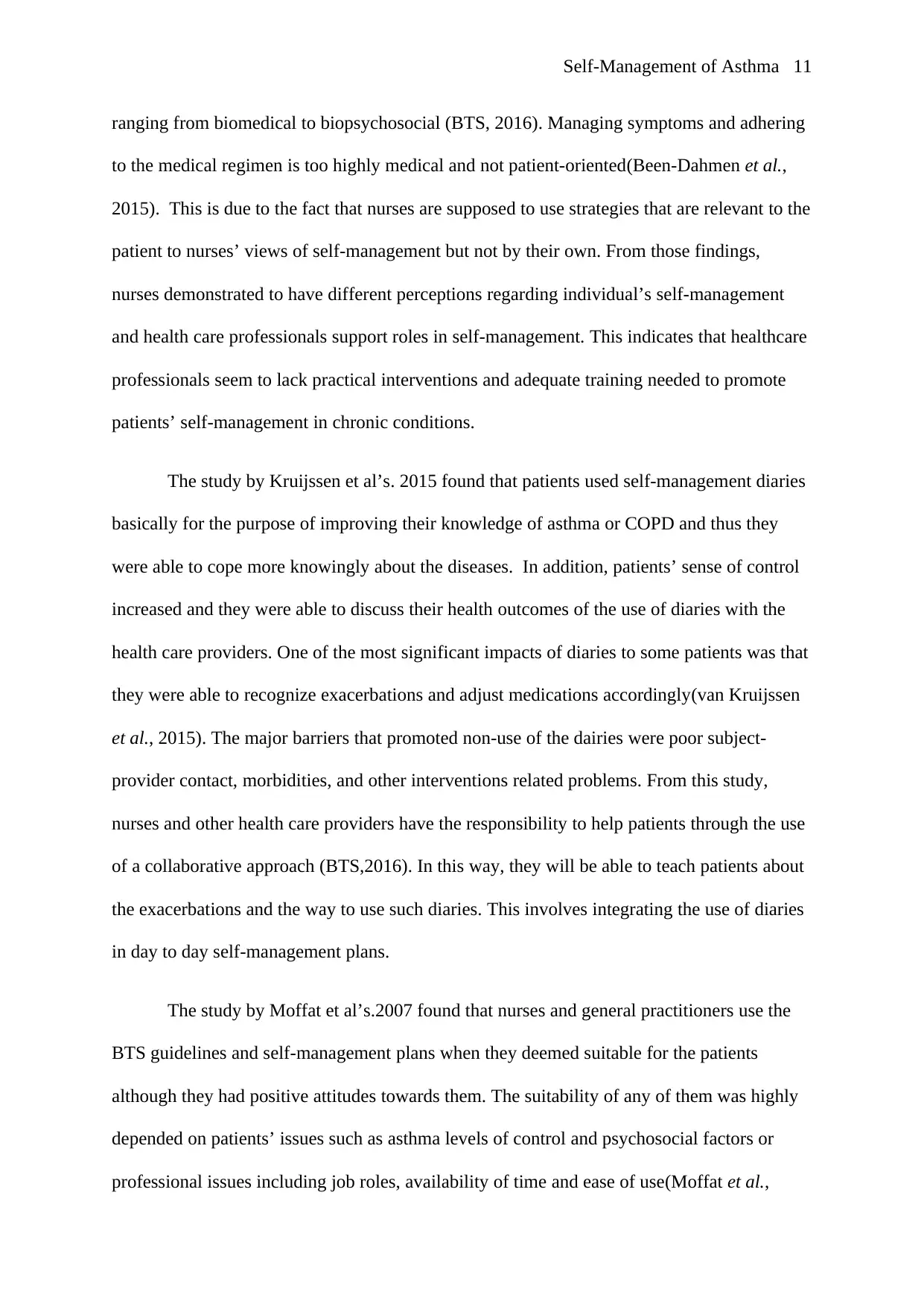
Self-Management of Asthma 11
ranging from biomedical to biopsychosocial (BTS, 2016). Managing symptoms and adhering
to the medical regimen is too highly medical and not patient-oriented(Been-Dahmen et al.,
2015). This is due to the fact that nurses are supposed to use strategies that are relevant to the
patient to nurses’ views of self-management but not by their own. From those findings,
nurses demonstrated to have different perceptions regarding individual’s self-management
and health care professionals support roles in self-management. This indicates that healthcare
professionals seem to lack practical interventions and adequate training needed to promote
patients’ self-management in chronic conditions.
The study by Kruijssen et al’s. 2015 found that patients used self-management diaries
basically for the purpose of improving their knowledge of asthma or COPD and thus they
were able to cope more knowingly about the diseases. In addition, patients’ sense of control
increased and they were able to discuss their health outcomes of the use of diaries with the
health care providers. One of the most significant impacts of diaries to some patients was that
they were able to recognize exacerbations and adjust medications accordingly(van Kruijssen
et al., 2015). The major barriers that promoted non-use of the dairies were poor subject-
provider contact, morbidities, and other interventions related problems. From this study,
nurses and other health care providers have the responsibility to help patients through the use
of a collaborative approach (BTS,2016). In this way, they will be able to teach patients about
the exacerbations and the way to use such diaries. This involves integrating the use of diaries
in day to day self-management plans.
The study by Moffat et al’s.2007 found that nurses and general practitioners use the
BTS guidelines and self-management plans when they deemed suitable for the patients
although they had positive attitudes towards them. The suitability of any of them was highly
depended on patients’ issues such as asthma levels of control and psychosocial factors or
professional issues including job roles, availability of time and ease of use(Moffat et al.,
ranging from biomedical to biopsychosocial (BTS, 2016). Managing symptoms and adhering
to the medical regimen is too highly medical and not patient-oriented(Been-Dahmen et al.,
2015). This is due to the fact that nurses are supposed to use strategies that are relevant to the
patient to nurses’ views of self-management but not by their own. From those findings,
nurses demonstrated to have different perceptions regarding individual’s self-management
and health care professionals support roles in self-management. This indicates that healthcare
professionals seem to lack practical interventions and adequate training needed to promote
patients’ self-management in chronic conditions.
The study by Kruijssen et al’s. 2015 found that patients used self-management diaries
basically for the purpose of improving their knowledge of asthma or COPD and thus they
were able to cope more knowingly about the diseases. In addition, patients’ sense of control
increased and they were able to discuss their health outcomes of the use of diaries with the
health care providers. One of the most significant impacts of diaries to some patients was that
they were able to recognize exacerbations and adjust medications accordingly(van Kruijssen
et al., 2015). The major barriers that promoted non-use of the dairies were poor subject-
provider contact, morbidities, and other interventions related problems. From this study,
nurses and other health care providers have the responsibility to help patients through the use
of a collaborative approach (BTS,2016). In this way, they will be able to teach patients about
the exacerbations and the way to use such diaries. This involves integrating the use of diaries
in day to day self-management plans.
The study by Moffat et al’s.2007 found that nurses and general practitioners use the
BTS guidelines and self-management plans when they deemed suitable for the patients
although they had positive attitudes towards them. The suitability of any of them was highly
depended on patients’ issues such as asthma levels of control and psychosocial factors or
professional issues including job roles, availability of time and ease of use(Moffat et al.,
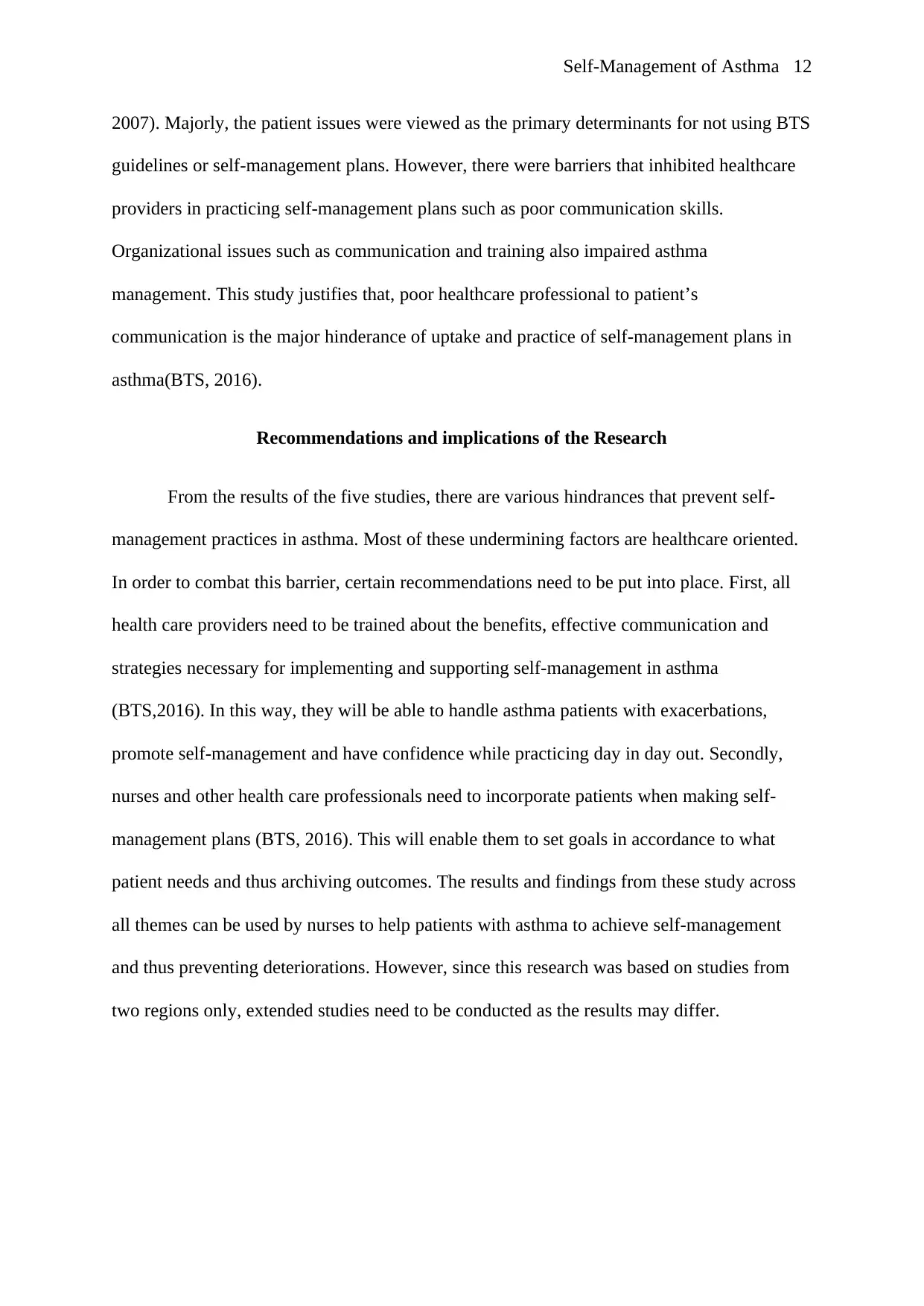
Self-Management of Asthma 12
2007). Majorly, the patient issues were viewed as the primary determinants for not using BTS
guidelines or self-management plans. However, there were barriers that inhibited healthcare
providers in practicing self-management plans such as poor communication skills.
Organizational issues such as communication and training also impaired asthma
management. This study justifies that, poor healthcare professional to patient’s
communication is the major hinderance of uptake and practice of self-management plans in
asthma(BTS, 2016).
Recommendations and implications of the Research
From the results of the five studies, there are various hindrances that prevent self-
management practices in asthma. Most of these undermining factors are healthcare oriented.
In order to combat this barrier, certain recommendations need to be put into place. First, all
health care providers need to be trained about the benefits, effective communication and
strategies necessary for implementing and supporting self-management in asthma
(BTS,2016). In this way, they will be able to handle asthma patients with exacerbations,
promote self-management and have confidence while practicing day in day out. Secondly,
nurses and other health care professionals need to incorporate patients when making self-
management plans (BTS, 2016). This will enable them to set goals in accordance to what
patient needs and thus archiving outcomes. The results and findings from these study across
all themes can be used by nurses to help patients with asthma to achieve self-management
and thus preventing deteriorations. However, since this research was based on studies from
two regions only, extended studies need to be conducted as the results may differ.
2007). Majorly, the patient issues were viewed as the primary determinants for not using BTS
guidelines or self-management plans. However, there were barriers that inhibited healthcare
providers in practicing self-management plans such as poor communication skills.
Organizational issues such as communication and training also impaired asthma
management. This study justifies that, poor healthcare professional to patient’s
communication is the major hinderance of uptake and practice of self-management plans in
asthma(BTS, 2016).
Recommendations and implications of the Research
From the results of the five studies, there are various hindrances that prevent self-
management practices in asthma. Most of these undermining factors are healthcare oriented.
In order to combat this barrier, certain recommendations need to be put into place. First, all
health care providers need to be trained about the benefits, effective communication and
strategies necessary for implementing and supporting self-management in asthma
(BTS,2016). In this way, they will be able to handle asthma patients with exacerbations,
promote self-management and have confidence while practicing day in day out. Secondly,
nurses and other health care professionals need to incorporate patients when making self-
management plans (BTS, 2016). This will enable them to set goals in accordance to what
patient needs and thus archiving outcomes. The results and findings from these study across
all themes can be used by nurses to help patients with asthma to achieve self-management
and thus preventing deteriorations. However, since this research was based on studies from
two regions only, extended studies need to be conducted as the results may differ.
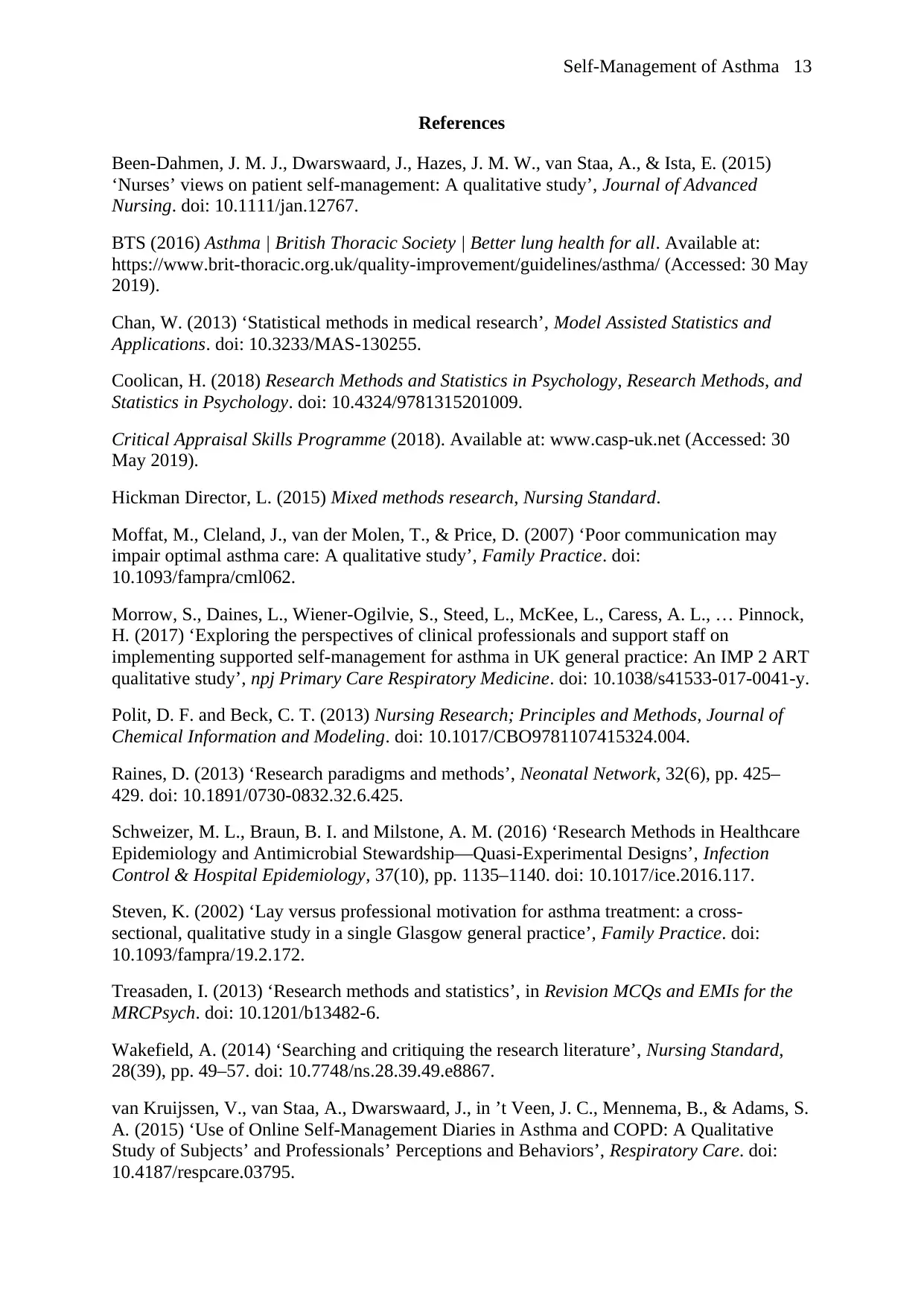
Self-Management of Asthma 13
References
Been-Dahmen, J. M. J., Dwarswaard, J., Hazes, J. M. W., van Staa, A., & Ista, E. (2015)
‘Nurses’ views on patient self-management: A qualitative study’, Journal of Advanced
Nursing. doi: 10.1111/jan.12767.
BTS (2016) Asthma | British Thoracic Society | Better lung health for all. Available at:
https://www.brit-thoracic.org.uk/quality-improvement/guidelines/asthma/ (Accessed: 30 May
2019).
Chan, W. (2013) ‘Statistical methods in medical research’, Model Assisted Statistics and
Applications. doi: 10.3233/MAS-130255.
Coolican, H. (2018) Research Methods and Statistics in Psychology, Research Methods, and
Statistics in Psychology. doi: 10.4324/9781315201009.
Critical Appraisal Skills Programme (2018). Available at: www.casp-uk.net (Accessed: 30
May 2019).
Hickman Director, L. (2015) Mixed methods research, Nursing Standard.
Moffat, M., Cleland, J., van der Molen, T., & Price, D. (2007) ‘Poor communication may
impair optimal asthma care: A qualitative study’, Family Practice. doi:
10.1093/fampra/cml062.
Morrow, S., Daines, L., Wiener-Ogilvie, S., Steed, L., McKee, L., Caress, A. L., … Pinnock,
H. (2017) ‘Exploring the perspectives of clinical professionals and support staff on
implementing supported self-management for asthma in UK general practice: An IMP 2 ART
qualitative study’, npj Primary Care Respiratory Medicine. doi: 10.1038/s41533-017-0041-y.
Polit, D. F. and Beck, C. T. (2013) Nursing Research; Principles and Methods, Journal of
Chemical Information and Modeling. doi: 10.1017/CBO9781107415324.004.
Raines, D. (2013) ‘Research paradigms and methods’, Neonatal Network, 32(6), pp. 425–
429. doi: 10.1891/0730-0832.32.6.425.
Schweizer, M. L., Braun, B. I. and Milstone, A. M. (2016) ‘Research Methods in Healthcare
Epidemiology and Antimicrobial Stewardship—Quasi-Experimental Designs’, Infection
Control & Hospital Epidemiology, 37(10), pp. 1135–1140. doi: 10.1017/ice.2016.117.
Steven, K. (2002) ‘Lay versus professional motivation for asthma treatment: a cross-
sectional, qualitative study in a single Glasgow general practice’, Family Practice. doi:
10.1093/fampra/19.2.172.
Treasaden, I. (2013) ‘Research methods and statistics’, in Revision MCQs and EMIs for the
MRCPsych. doi: 10.1201/b13482-6.
Wakefield, A. (2014) ‘Searching and critiquing the research literature’, Nursing Standard,
28(39), pp. 49–57. doi: 10.7748/ns.28.39.49.e8867.
van Kruijssen, V., van Staa, A., Dwarswaard, J., in ’t Veen, J. C., Mennema, B., & Adams, S.
A. (2015) ‘Use of Online Self-Management Diaries in Asthma and COPD: A Qualitative
Study of Subjects’ and Professionals’ Perceptions and Behaviors’, Respiratory Care. doi:
10.4187/respcare.03795.
References
Been-Dahmen, J. M. J., Dwarswaard, J., Hazes, J. M. W., van Staa, A., & Ista, E. (2015)
‘Nurses’ views on patient self-management: A qualitative study’, Journal of Advanced
Nursing. doi: 10.1111/jan.12767.
BTS (2016) Asthma | British Thoracic Society | Better lung health for all. Available at:
https://www.brit-thoracic.org.uk/quality-improvement/guidelines/asthma/ (Accessed: 30 May
2019).
Chan, W. (2013) ‘Statistical methods in medical research’, Model Assisted Statistics and
Applications. doi: 10.3233/MAS-130255.
Coolican, H. (2018) Research Methods and Statistics in Psychology, Research Methods, and
Statistics in Psychology. doi: 10.4324/9781315201009.
Critical Appraisal Skills Programme (2018). Available at: www.casp-uk.net (Accessed: 30
May 2019).
Hickman Director, L. (2015) Mixed methods research, Nursing Standard.
Moffat, M., Cleland, J., van der Molen, T., & Price, D. (2007) ‘Poor communication may
impair optimal asthma care: A qualitative study’, Family Practice. doi:
10.1093/fampra/cml062.
Morrow, S., Daines, L., Wiener-Ogilvie, S., Steed, L., McKee, L., Caress, A. L., … Pinnock,
H. (2017) ‘Exploring the perspectives of clinical professionals and support staff on
implementing supported self-management for asthma in UK general practice: An IMP 2 ART
qualitative study’, npj Primary Care Respiratory Medicine. doi: 10.1038/s41533-017-0041-y.
Polit, D. F. and Beck, C. T. (2013) Nursing Research; Principles and Methods, Journal of
Chemical Information and Modeling. doi: 10.1017/CBO9781107415324.004.
Raines, D. (2013) ‘Research paradigms and methods’, Neonatal Network, 32(6), pp. 425–
429. doi: 10.1891/0730-0832.32.6.425.
Schweizer, M. L., Braun, B. I. and Milstone, A. M. (2016) ‘Research Methods in Healthcare
Epidemiology and Antimicrobial Stewardship—Quasi-Experimental Designs’, Infection
Control & Hospital Epidemiology, 37(10), pp. 1135–1140. doi: 10.1017/ice.2016.117.
Steven, K. (2002) ‘Lay versus professional motivation for asthma treatment: a cross-
sectional, qualitative study in a single Glasgow general practice’, Family Practice. doi:
10.1093/fampra/19.2.172.
Treasaden, I. (2013) ‘Research methods and statistics’, in Revision MCQs and EMIs for the
MRCPsych. doi: 10.1201/b13482-6.
Wakefield, A. (2014) ‘Searching and critiquing the research literature’, Nursing Standard,
28(39), pp. 49–57. doi: 10.7748/ns.28.39.49.e8867.
van Kruijssen, V., van Staa, A., Dwarswaard, J., in ’t Veen, J. C., Mennema, B., & Adams, S.
A. (2015) ‘Use of Online Self-Management Diaries in Asthma and COPD: A Qualitative
Study of Subjects’ and Professionals’ Perceptions and Behaviors’, Respiratory Care. doi:
10.4187/respcare.03795.
Paraphrase This Document
Need a fresh take? Get an instant paraphrase of this document with our AI Paraphraser
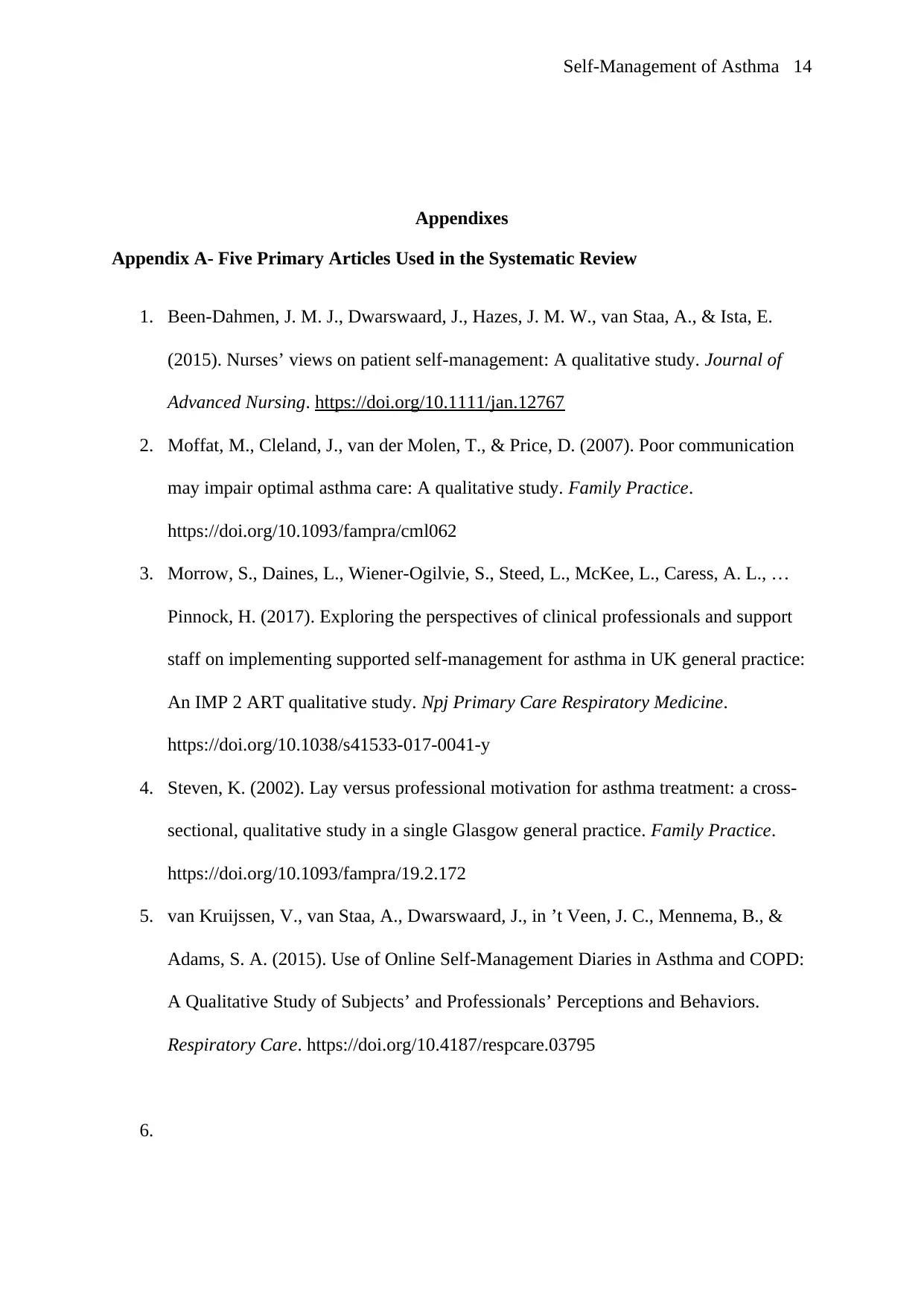
Self-Management of Asthma 14
Appendixes
Appendix A- Five Primary Articles Used in the Systematic Review
1. Been-Dahmen, J. M. J., Dwarswaard, J., Hazes, J. M. W., van Staa, A., & Ista, E.
(2015). Nurses’ views on patient self-management: A qualitative study. Journal of
Advanced Nursing. https://doi.org/10.1111/jan.12767
2. Moffat, M., Cleland, J., van der Molen, T., & Price, D. (2007). Poor communication
may impair optimal asthma care: A qualitative study. Family Practice.
https://doi.org/10.1093/fampra/cml062
3. Morrow, S., Daines, L., Wiener-Ogilvie, S., Steed, L., McKee, L., Caress, A. L., …
Pinnock, H. (2017). Exploring the perspectives of clinical professionals and support
staff on implementing supported self-management for asthma in UK general practice:
An IMP 2 ART qualitative study. Npj Primary Care Respiratory Medicine.
https://doi.org/10.1038/s41533-017-0041-y
4. Steven, K. (2002). Lay versus professional motivation for asthma treatment: a cross-
sectional, qualitative study in a single Glasgow general practice. Family Practice.
https://doi.org/10.1093/fampra/19.2.172
5. van Kruijssen, V., van Staa, A., Dwarswaard, J., in ’t Veen, J. C., Mennema, B., &
Adams, S. A. (2015). Use of Online Self-Management Diaries in Asthma and COPD:
A Qualitative Study of Subjects’ and Professionals’ Perceptions and Behaviors.
Respiratory Care. https://doi.org/10.4187/respcare.03795
6.
Appendixes
Appendix A- Five Primary Articles Used in the Systematic Review
1. Been-Dahmen, J. M. J., Dwarswaard, J., Hazes, J. M. W., van Staa, A., & Ista, E.
(2015). Nurses’ views on patient self-management: A qualitative study. Journal of
Advanced Nursing. https://doi.org/10.1111/jan.12767
2. Moffat, M., Cleland, J., van der Molen, T., & Price, D. (2007). Poor communication
may impair optimal asthma care: A qualitative study. Family Practice.
https://doi.org/10.1093/fampra/cml062
3. Morrow, S., Daines, L., Wiener-Ogilvie, S., Steed, L., McKee, L., Caress, A. L., …
Pinnock, H. (2017). Exploring the perspectives of clinical professionals and support
staff on implementing supported self-management for asthma in UK general practice:
An IMP 2 ART qualitative study. Npj Primary Care Respiratory Medicine.
https://doi.org/10.1038/s41533-017-0041-y
4. Steven, K. (2002). Lay versus professional motivation for asthma treatment: a cross-
sectional, qualitative study in a single Glasgow general practice. Family Practice.
https://doi.org/10.1093/fampra/19.2.172
5. van Kruijssen, V., van Staa, A., Dwarswaard, J., in ’t Veen, J. C., Mennema, B., &
Adams, S. A. (2015). Use of Online Self-Management Diaries in Asthma and COPD:
A Qualitative Study of Subjects’ and Professionals’ Perceptions and Behaviors.
Respiratory Care. https://doi.org/10.4187/respcare.03795
6.
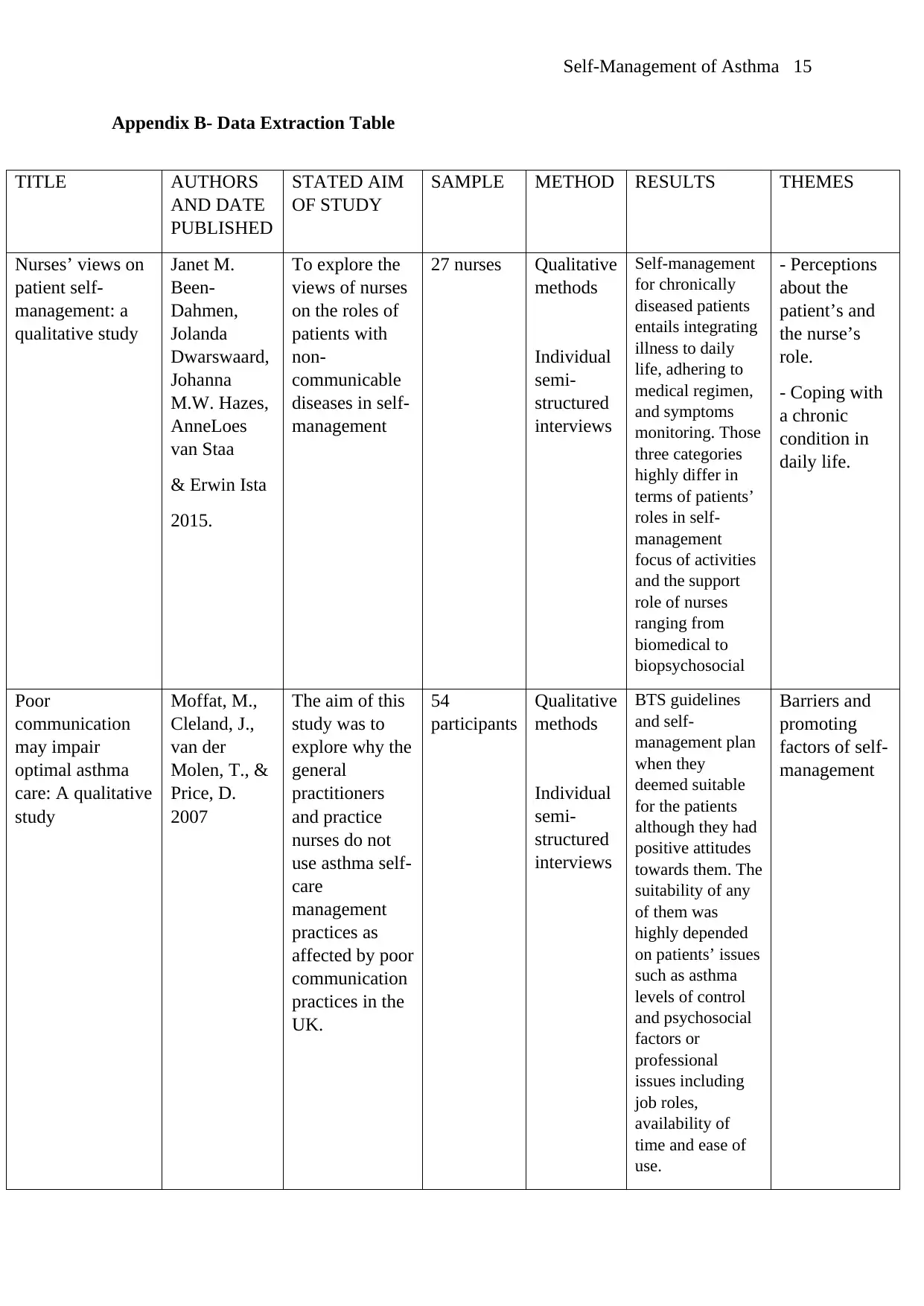
Self-Management of Asthma 15
Appendix B- Data Extraction Table
TITLE AUTHORS
AND DATE
PUBLISHED
STATED AIM
OF STUDY
SAMPLE METHOD RESULTS THEMES
Nurses’ views on
patient self-
management: a
qualitative study
Janet M.
Been-
Dahmen,
Jolanda
Dwarswaard,
Johanna
M.W. Hazes,
AnneLoes
van Staa
& Erwin Ista
2015.
To explore the
views of nurses
on the roles of
patients with
non-
communicable
diseases in self-
management
27 nurses Qualitative
methods
Individual
semi-
structured
interviews
Self-management
for chronically
diseased patients
entails integrating
illness to daily
life, adhering to
medical regimen,
and symptoms
monitoring. Those
three categories
highly differ in
terms of patients’
roles in self-
management
focus of activities
and the support
role of nurses
ranging from
biomedical to
biopsychosocial
- Perceptions
about the
patient’s and
the nurse’s
role.
- Coping with
a chronic
condition in
daily life.
Poor
communication
may impair
optimal asthma
care: A qualitative
study
Moffat, M.,
Cleland, J.,
van der
Molen, T., &
Price, D.
2007
The aim of this
study was to
explore why the
general
practitioners
and practice
nurses do not
use asthma self-
care
management
practices as
affected by poor
communication
practices in the
UK.
54
participants
Qualitative
methods
Individual
semi-
structured
interviews
BTS guidelines
and self-
management plan
when they
deemed suitable
for the patients
although they had
positive attitudes
towards them. The
suitability of any
of them was
highly depended
on patients’ issues
such as asthma
levels of control
and psychosocial
factors or
professional
issues including
job roles,
availability of
time and ease of
use.
Barriers and
promoting
factors of self-
management
Appendix B- Data Extraction Table
TITLE AUTHORS
AND DATE
PUBLISHED
STATED AIM
OF STUDY
SAMPLE METHOD RESULTS THEMES
Nurses’ views on
patient self-
management: a
qualitative study
Janet M.
Been-
Dahmen,
Jolanda
Dwarswaard,
Johanna
M.W. Hazes,
AnneLoes
van Staa
& Erwin Ista
2015.
To explore the
views of nurses
on the roles of
patients with
non-
communicable
diseases in self-
management
27 nurses Qualitative
methods
Individual
semi-
structured
interviews
Self-management
for chronically
diseased patients
entails integrating
illness to daily
life, adhering to
medical regimen,
and symptoms
monitoring. Those
three categories
highly differ in
terms of patients’
roles in self-
management
focus of activities
and the support
role of nurses
ranging from
biomedical to
biopsychosocial
- Perceptions
about the
patient’s and
the nurse’s
role.
- Coping with
a chronic
condition in
daily life.
Poor
communication
may impair
optimal asthma
care: A qualitative
study
Moffat, M.,
Cleland, J.,
van der
Molen, T., &
Price, D.
2007
The aim of this
study was to
explore why the
general
practitioners
and practice
nurses do not
use asthma self-
care
management
practices as
affected by poor
communication
practices in the
UK.
54
participants
Qualitative
methods
Individual
semi-
structured
interviews
BTS guidelines
and self-
management plan
when they
deemed suitable
for the patients
although they had
positive attitudes
towards them. The
suitability of any
of them was
highly depended
on patients’ issues
such as asthma
levels of control
and psychosocial
factors or
professional
issues including
job roles,
availability of
time and ease of
use.
Barriers and
promoting
factors of self-
management
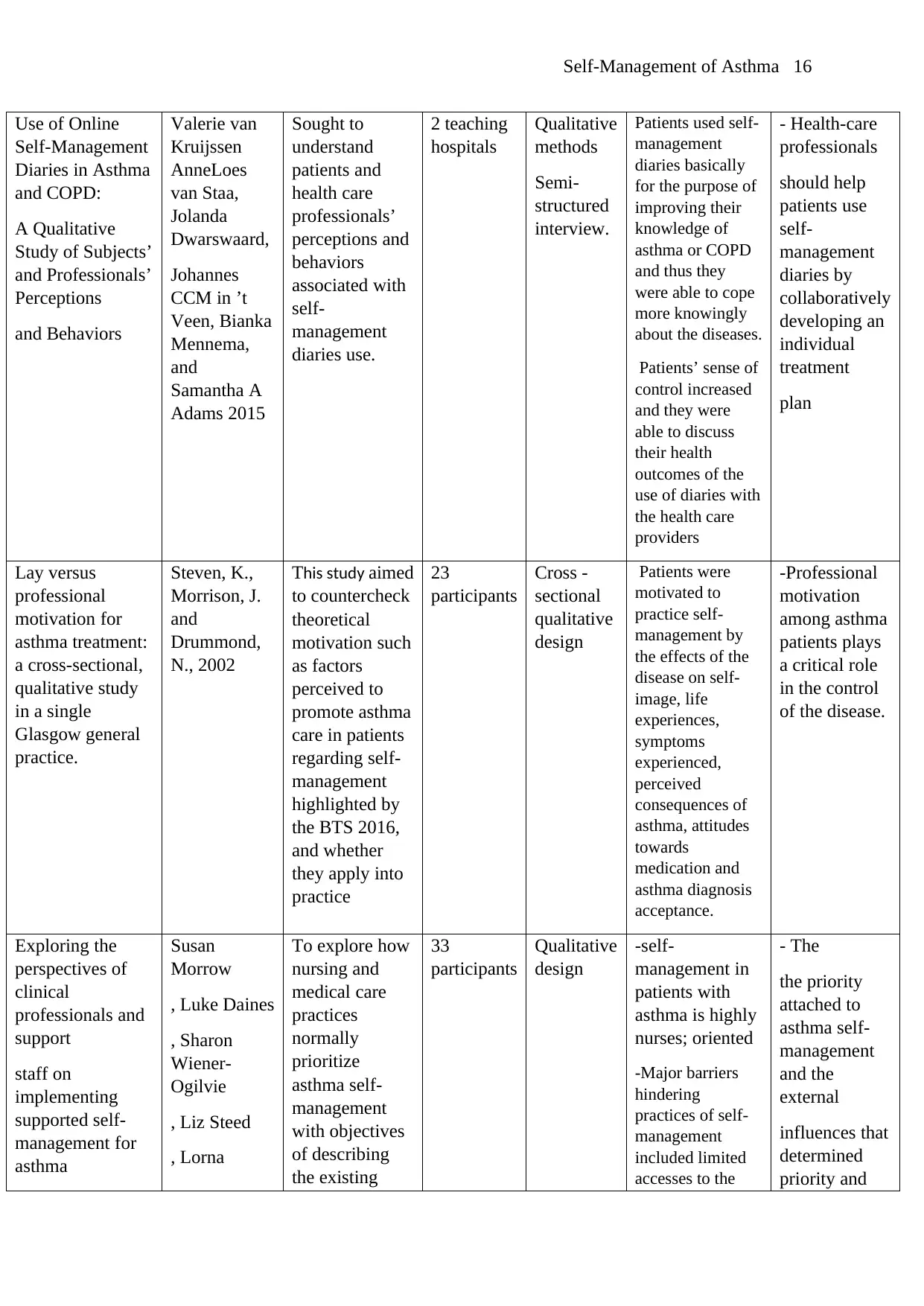
Self-Management of Asthma 16
Use of Online
Self-Management
Diaries in Asthma
and COPD:
A Qualitative
Study of Subjects’
and Professionals’
Perceptions
and Behaviors
Valerie van
Kruijssen
AnneLoes
van Staa,
Jolanda
Dwarswaard,
Johannes
CCM in ’t
Veen, Bianka
Mennema,
and
Samantha A
Adams 2015
Sought to
understand
patients and
health care
professionals’
perceptions and
behaviors
associated with
self-
management
diaries use.
2 teaching
hospitals
Qualitative
methods
Semi-
structured
interview.
Patients used self-
management
diaries basically
for the purpose of
improving their
knowledge of
asthma or COPD
and thus they
were able to cope
more knowingly
about the diseases.
Patients’ sense of
control increased
and they were
able to discuss
their health
outcomes of the
use of diaries with
the health care
providers
- Health-care
professionals
should help
patients use
self-
management
diaries by
collaboratively
developing an
individual
treatment
plan
Lay versus
professional
motivation for
asthma treatment:
a cross-sectional,
qualitative study
in a single
Glasgow general
practice.
Steven, K.,
Morrison, J.
and
Drummond,
N., 2002
This study aimed
to countercheck
theoretical
motivation such
as factors
perceived to
promote asthma
care in patients
regarding self-
management
highlighted by
the BTS 2016,
and whether
they apply into
practice
23
participants
Cross -
sectional
qualitative
design
Patients were
motivated to
practice self-
management by
the effects of the
disease on self-
image, life
experiences,
symptoms
experienced,
perceived
consequences of
asthma, attitudes
towards
medication and
asthma diagnosis
acceptance.
-Professional
motivation
among asthma
patients plays
a critical role
in the control
of the disease.
Exploring the
perspectives of
clinical
professionals and
support
staff on
implementing
supported self-
management for
asthma
Susan
Morrow
, Luke Daines
, Sharon
Wiener-
Ogilvie
, Liz Steed
, Lorna
To explore how
nursing and
medical care
practices
normally
prioritize
asthma self-
management
with objectives
of describing
the existing
33
participants
Qualitative
design
-self-
management in
patients with
asthma is highly
nurses; oriented
-Major barriers
hindering
practices of self-
management
included limited
accesses to the
- The
the priority
attached to
asthma self-
management
and the
external
influences that
determined
priority and
Use of Online
Self-Management
Diaries in Asthma
and COPD:
A Qualitative
Study of Subjects’
and Professionals’
Perceptions
and Behaviors
Valerie van
Kruijssen
AnneLoes
van Staa,
Jolanda
Dwarswaard,
Johannes
CCM in ’t
Veen, Bianka
Mennema,
and
Samantha A
Adams 2015
Sought to
understand
patients and
health care
professionals’
perceptions and
behaviors
associated with
self-
management
diaries use.
2 teaching
hospitals
Qualitative
methods
Semi-
structured
interview.
Patients used self-
management
diaries basically
for the purpose of
improving their
knowledge of
asthma or COPD
and thus they
were able to cope
more knowingly
about the diseases.
Patients’ sense of
control increased
and they were
able to discuss
their health
outcomes of the
use of diaries with
the health care
providers
- Health-care
professionals
should help
patients use
self-
management
diaries by
collaboratively
developing an
individual
treatment
plan
Lay versus
professional
motivation for
asthma treatment:
a cross-sectional,
qualitative study
in a single
Glasgow general
practice.
Steven, K.,
Morrison, J.
and
Drummond,
N., 2002
This study aimed
to countercheck
theoretical
motivation such
as factors
perceived to
promote asthma
care in patients
regarding self-
management
highlighted by
the BTS 2016,
and whether
they apply into
practice
23
participants
Cross -
sectional
qualitative
design
Patients were
motivated to
practice self-
management by
the effects of the
disease on self-
image, life
experiences,
symptoms
experienced,
perceived
consequences of
asthma, attitudes
towards
medication and
asthma diagnosis
acceptance.
-Professional
motivation
among asthma
patients plays
a critical role
in the control
of the disease.
Exploring the
perspectives of
clinical
professionals and
support
staff on
implementing
supported self-
management for
asthma
Susan
Morrow
, Luke Daines
, Sharon
Wiener-
Ogilvie
, Liz Steed
, Lorna
To explore how
nursing and
medical care
practices
normally
prioritize
asthma self-
management
with objectives
of describing
the existing
33
participants
Qualitative
design
-self-
management in
patients with
asthma is highly
nurses; oriented
-Major barriers
hindering
practices of self-
management
included limited
accesses to the
- The
the priority
attached to
asthma self-
management
and the
external
influences that
determined
priority and
Secure Best Marks with AI Grader
Need help grading? Try our AI Grader for instant feedback on your assignments.

Self-Management of Asthma 17
in UK general
practice.
McKee
, Ann-Louise
Caress5
, Stephanie
C. Taylor and
Hilary
Pinnock
2017
routines,
barriers,
facilitators, and
major
innovative
strategies that
can be
practically
implemented to
support self-
care
management for
adults
rage of resources,
poor patient
attendance in the
patient clinics,
lack of time, and
consultations
competing
agendas brought
by multimorbidity
organization
The priority
attached to
asthma self-
management
and the
external
influences that
determined
priority and
organization
in UK general
practice.
McKee
, Ann-Louise
Caress5
, Stephanie
C. Taylor and
Hilary
Pinnock
2017
routines,
barriers,
facilitators, and
major
innovative
strategies that
can be
practically
implemented to
support self-
care
management for
adults
rage of resources,
poor patient
attendance in the
patient clinics,
lack of time, and
consultations
competing
agendas brought
by multimorbidity
organization
The priority
attached to
asthma self-
management
and the
external
influences that
determined
priority and
organization
1 out of 17
Related Documents
Your All-in-One AI-Powered Toolkit for Academic Success.
+13062052269
info@desklib.com
Available 24*7 on WhatsApp / Email
![[object Object]](/_next/static/media/star-bottom.7253800d.svg)
Unlock your academic potential
© 2024 | Zucol Services PVT LTD | All rights reserved.





